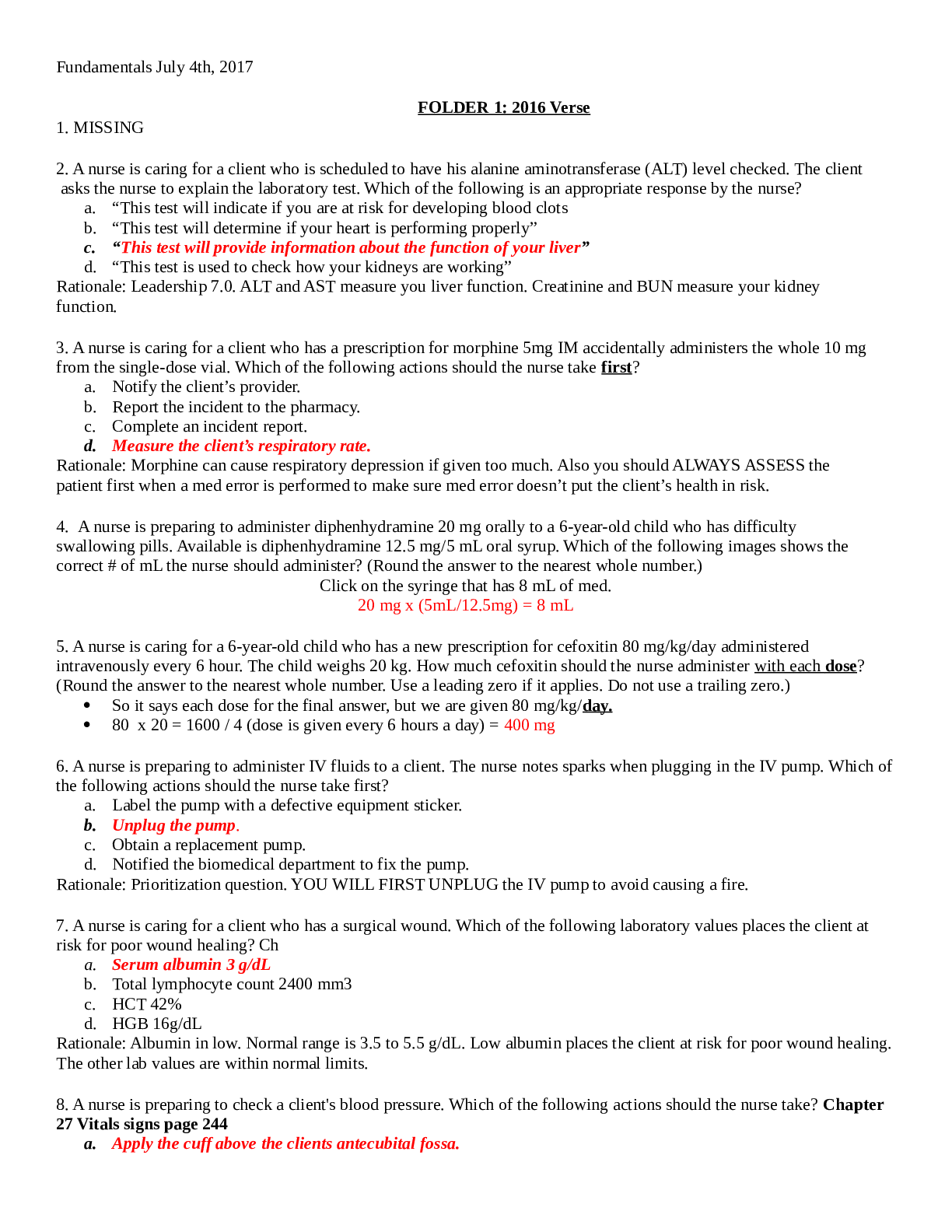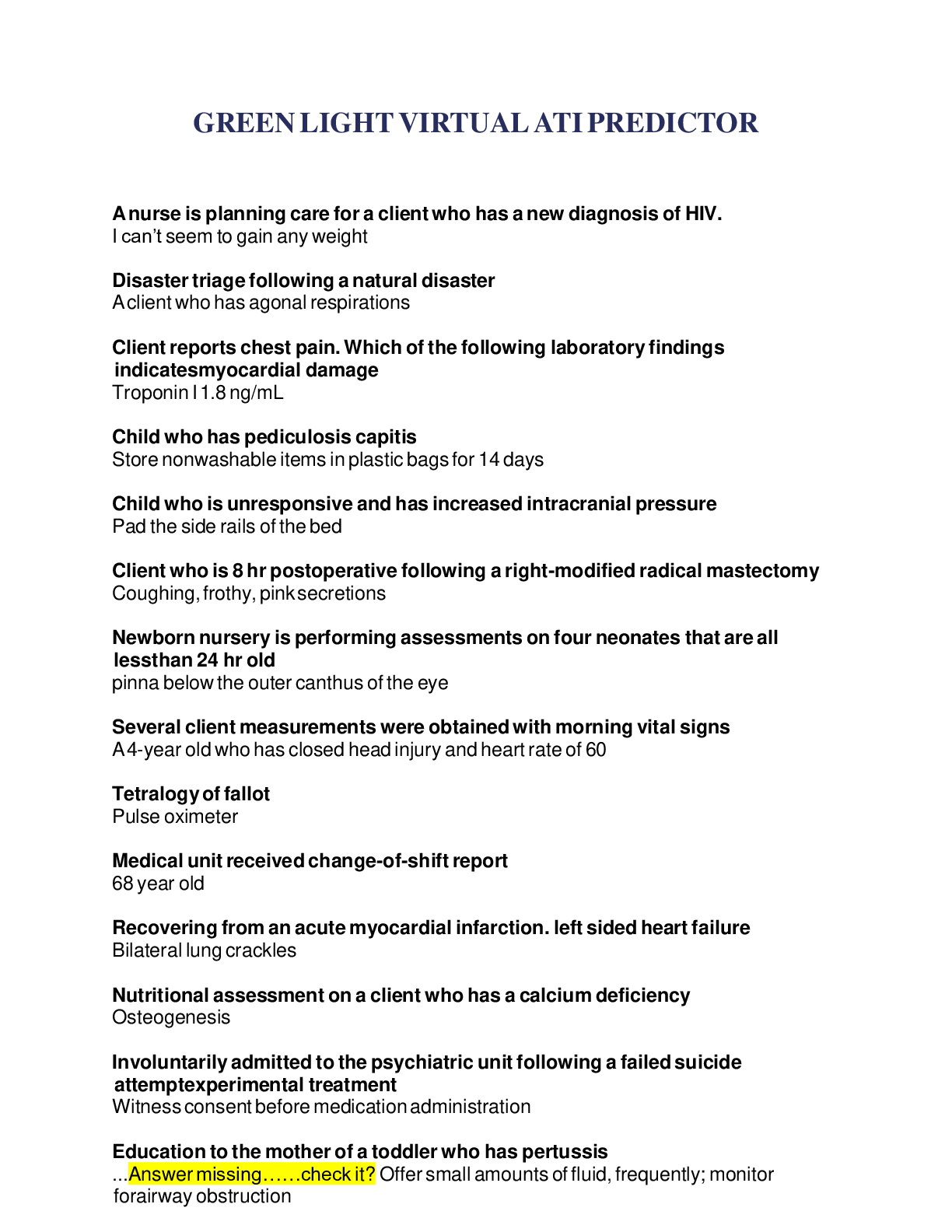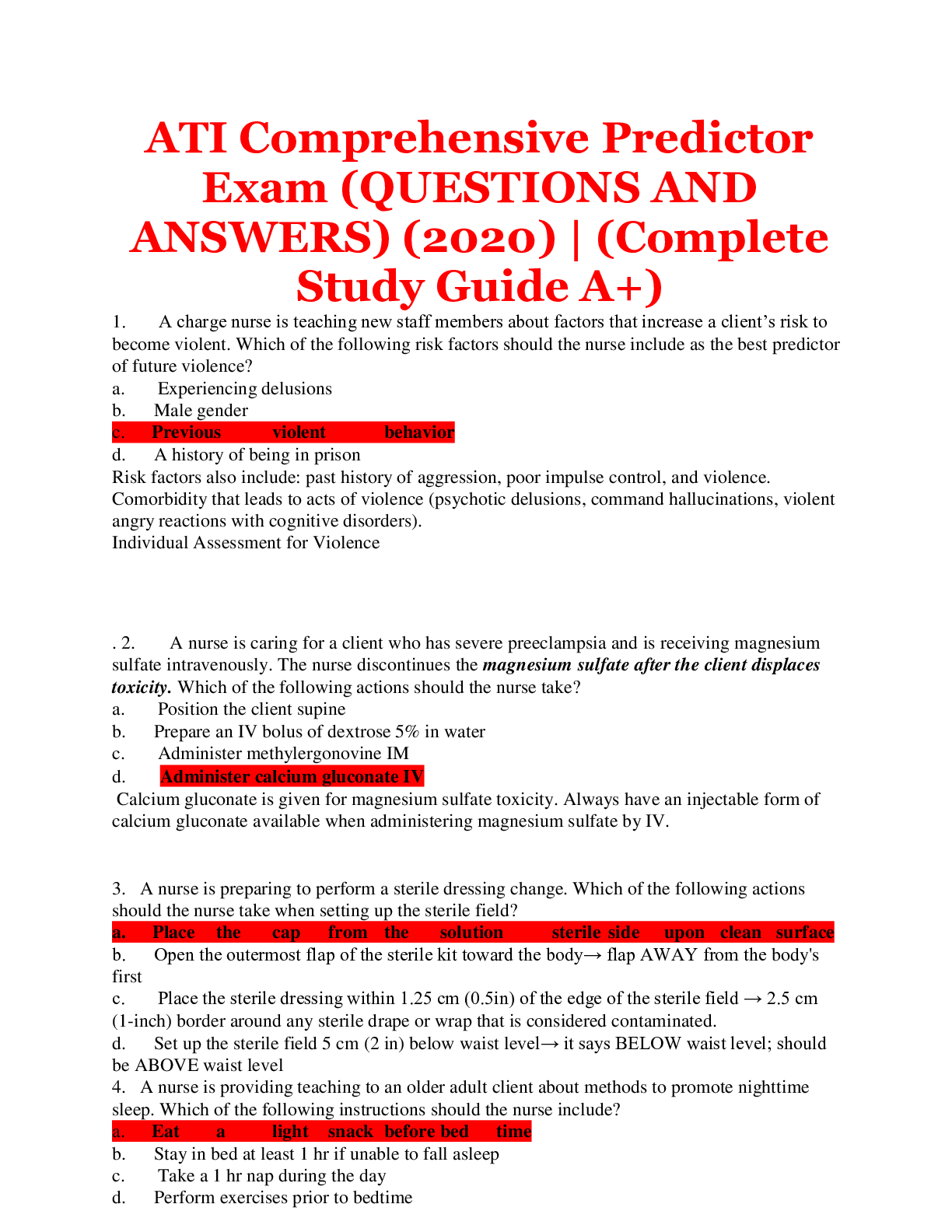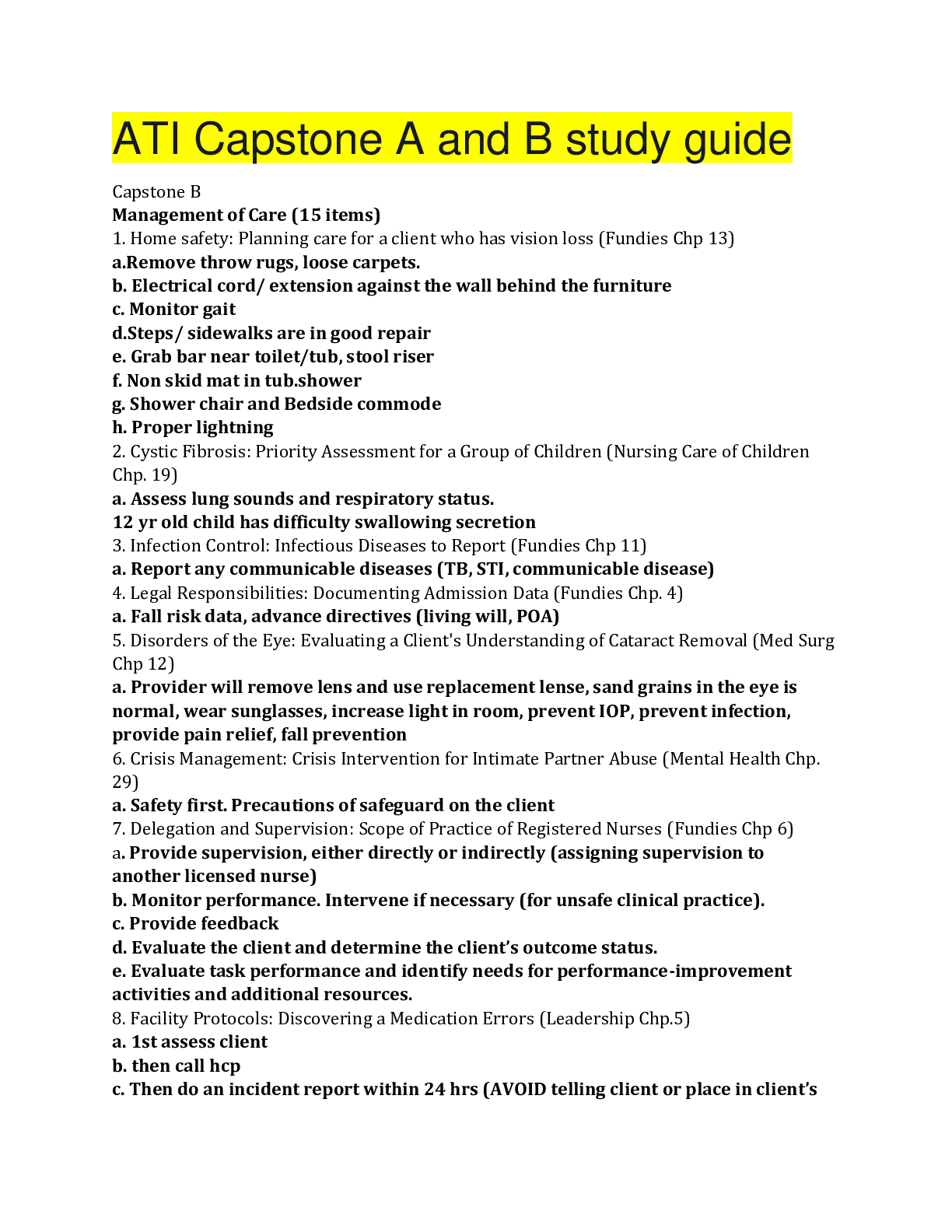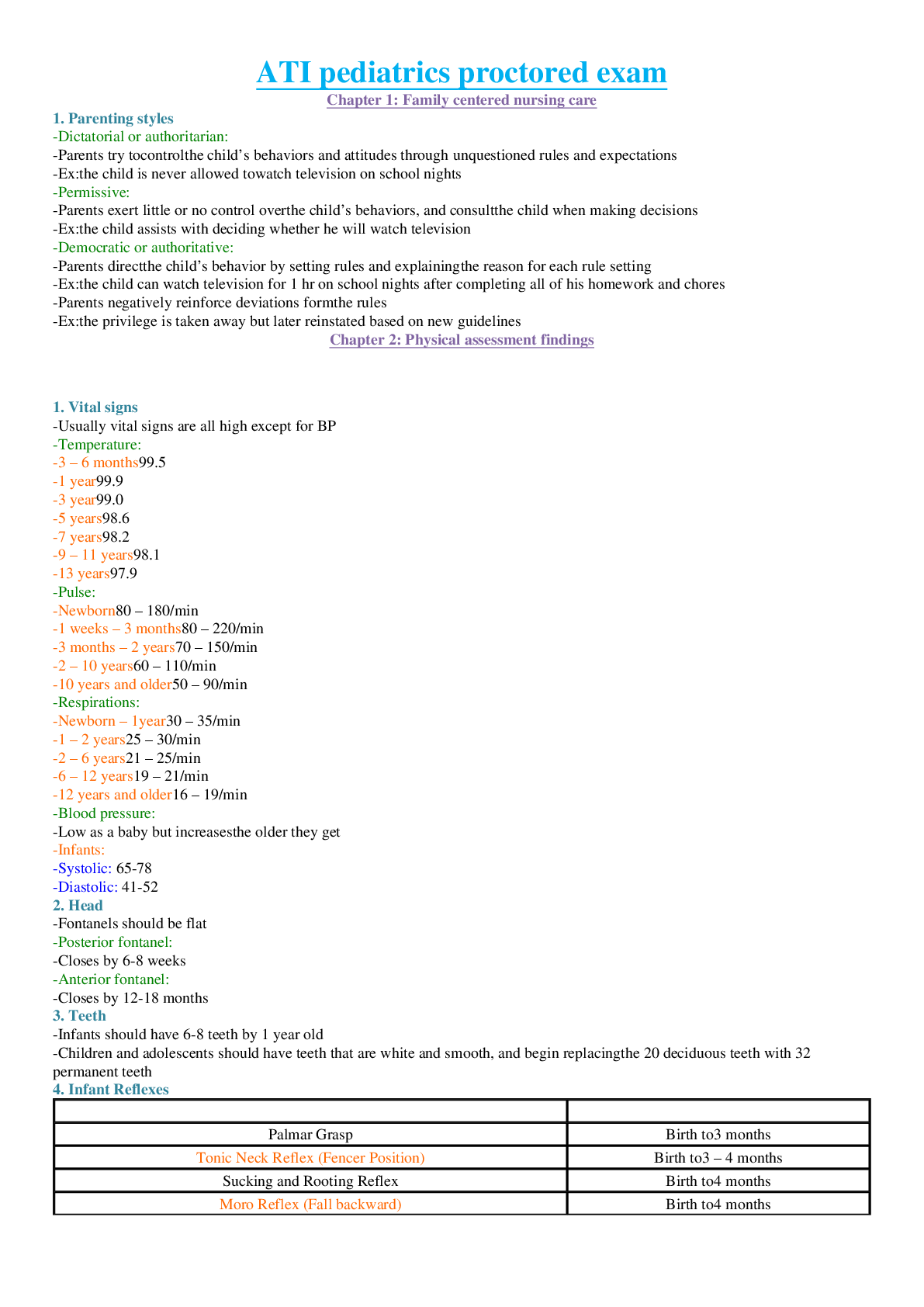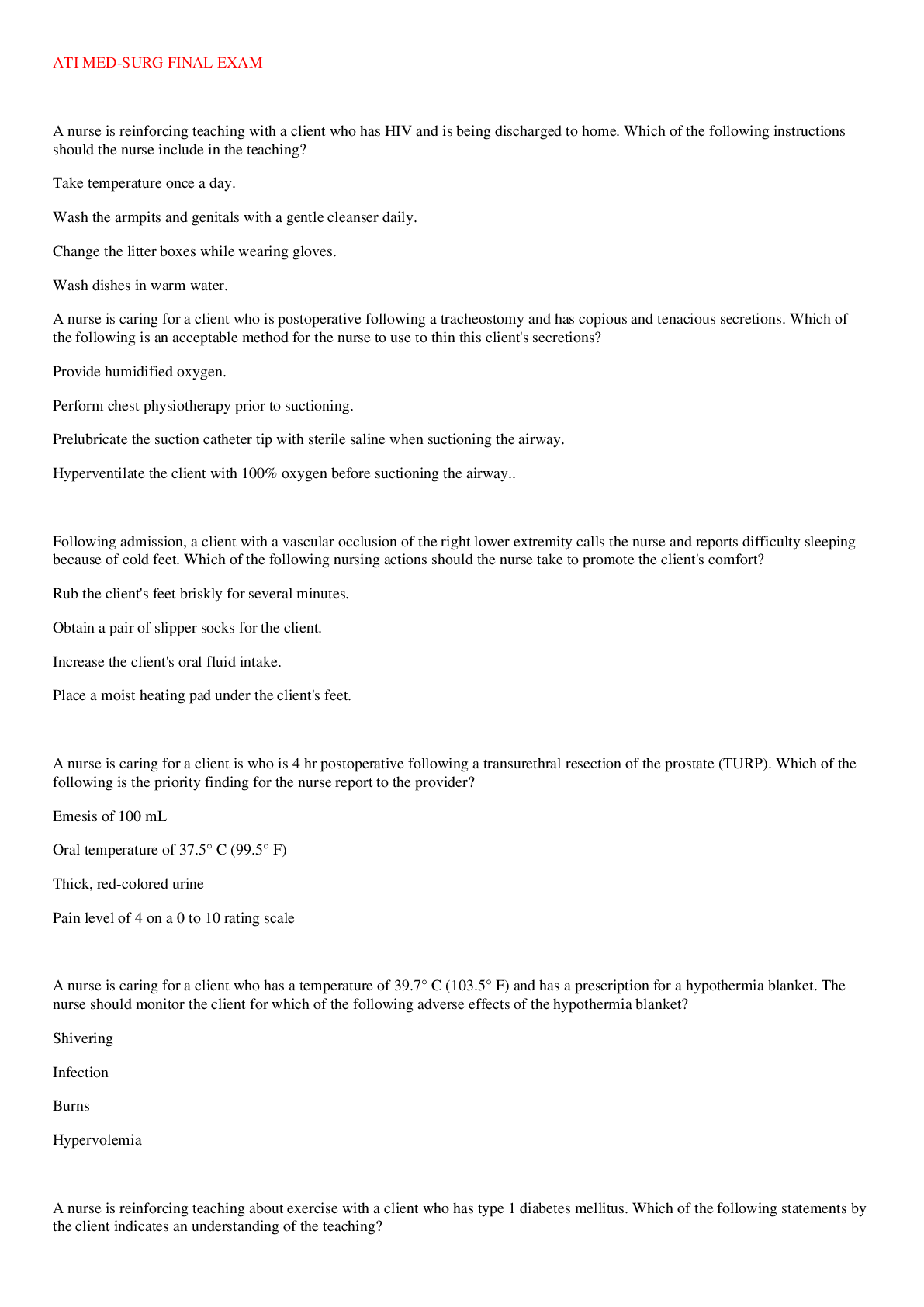*NURSING > QUESTIONS and ANSWERS > ATI RN Concept-Based Assessment EXIT EXAM (240 LATEST QUESTIONS) UPDATED 2020 (All)
ATI RN Concept-Based Assessment EXIT EXAM (240 LATEST QUESTIONS) UPDATED 2020
Document Content and Description Below
ATI RN Concept-Based Assessment Level 3 Exam Study Guide 1. Alteplase (tPA) - 2. characteristics of addictive behavior - 3. A charge nurse is discussing the care of a client who has major depressive d... isorder (MDD) with a newly licensed nurse. Which of the following statements by the newly licensed nurse indicates a need for further teaching? A. "Care during the continuation phase focuses on treating continued manifestations of MDD." B. "The goal of treatment during the maintenance phase is prevention of future episodes of MDD." C. "The client is at greatest risk for suicide during the first weeks of an MDD episode." D. "Medication and psychotherapy are used to prevent a relapse of MDD." 4. A charge nurse is reviewing Kübler ross: five stages of grief with a group of newly licensed nurses. Which of the following stages should the charge nurse include in the teaching? (select all that apply.) A. Disequilibrium B. Denial C. Bargaining D. Anger E. Depression 5. Child with Down Syndrome delayed development - nurse should ensure the child is enrolled in an early stimulation program which provides PHYSICAL THERAPY to develop motor skills. 6. The child with Down syndrome should be evaluated for which condition before participating in some sports? a. Hyperflexibility b. Cutis marmorata c. Atlantoaxial instability d. Speckling of iris (Brushfield spots) RATIONALE: 7. chlordiazepoxide Trade name: (librium) - 8. A client experiences a large gush of fluid from vagina while walking in the hallway of the birthing unit. Which of the following actions should the nurse take first? A. Check the amniotic fluid for meconium. B. Monitor FHR for distress. C. dry the client and make her comfortable. D. Monitor uterine contractions. RATIONALE: 9. A client who had an above-the-knee amputation reports having sharp, stabbing type of phantom pain. Which of the following is an appropriate action by the nurse? A. Facilitate counseling services. B. Encourage use of cold therapy. C. Question whether the pain is real. D. Administer an antiepileptic medication. RATIONALE: A 10. A client who has an expanding brain tumor is prescribed dexamethasone (Decadron). Which of the following are true regarding steroid therapy? (Select all that apply.) a. It is prescribed to reduce cerebral swelling b. Hypoglycemia is an expected adverse effect c. It can result in weight gain d. It has a diuretic effect e. It can cause fluid retention 11. Clonidine Trade name: (catapres) - 12. A community health nurse is leading a discussion about rape with a neighborhood task force. Which of the following statements by a neighborhood citizen indicates an understanding of the teaching? A. "Rape is a crime of passion." B. "Acquaintance rape often involves alcohol." C. "Young adults are the typical victims of sexual assault." D. "The majority of rapists are unknown to the victims." RATIONALE: 13. dissociative amnesia - 14. Education for preventing child-hood obesity - 15. G/P/A/L - 16. HELLP syndrome - 17. A home health nurse is teaching a client who has active tuberculosis. The provider has prescribed the following medication regimen: isoniazid (Nydrazid) 250 mg PO daily, rifampin (Rifadin) 500 mg PO daily, pyrazinamide 750 mg PO daily, and ethambutol (Myambutol) 1 mg PO daily. Which of the following client statements indicate understanding of the teaching? Select all that apply. A. "I can substitute one medication for another if I run out because they all fight infection." B. "I will wash my hands each time I cough." C. "I will wear a mask when I am in a public area." D. "I am glad I don't have to have any more sputum specimens." E. "I don't need to worry where I go once I start taking my medications." 18. how to care for client having late deceleration’s - 19. intimate partner violence teaching - 20. LAB VALUES suggestive of HELLP Syndrome - 21. Leukorrhea - 22. manifestations of acute glaucoma - 23. manifestations of DKA - 24. manifestations of increased ICP - 25. manifestations of prenatal complications - 26. Myelomeningocele (spina bifida) - 27. negative symptoms of schizophrenia - 28. A nurse educator in the labor and delivery unit is reviewing the use of chemical agents to promote cervical ripening with a group of newly hired nurses. Which of the following statements by a nurse indicates understanding of the teaching? A. "They are administered in an oral form." B. "They act by absorbing fluid from tissues." C. "They promote dilation of the os." D. "They include an amniotomy." RATIONALE: 29. A nurse educator is reviewing the use of cardiopulmonary bypass during surgery for coronary artery bypass grafting with a group of nurses. Which of the following should be included in the discussion? (Select all that apply.) A. The client's demand for oxygen is lowered. B. Motion of the heart ceases. C. Rewarming of the client takes place. D. The client's metabolic rate is increased. E. Blood flow to the heart is stopped. 30. A nurse in a clinic is caring for a client who has suspected uterine cancer. Which of the following assessment techniques should the nurse anticipate the provider will perform on this client? A. Bimanual pelvic examination B. Papanicolaou (Pap) test with cultures C. Digital rectal examination D. Percussion of the upper abdominal quadrants for tympany 31. A nurse in a clinic is reviewing the facility's testing process and procedures for human immune deficiency virus (HIV) with a new employee. Which of the following information should the nurse include in the review? A. In the presence of HIV, the enzyme immunoassay (EIA) test is typically reactive within 72 hours after the client is infected B. The Western blot assay is used to confirm diagnosis of HIV C. The Polymerase chain reaction (PRC) test is used to confirm diagnosis of HIV D. CD4 cell counts will be elevated in a client who is infected with HIV 32. A nurse in a clinic is teaching a client who has ulcerative colitis. Which of the following statements by the client indicates understanding of the teaching? A. "I will plan to limit fiber in my diet." B. "I will restrict fluid intake during meals." C."I will switch to black tea instead of drinking coffee." D."I will try to eat three moderates to large meals a day." RATIONALE: 33. A nurse in an acute mental health facility is caring for a client who has bipolar disorder. Which of the following is the priority nursing action? A. set consistent limits for expected behavior B. administer prescribed medications as scheduled C. provide the client with step-by-step instructions during hygiene activities D. monitor the client for escalating behavior RATIONALE: 34. A nurse in an oncology clinic is reviewing the health record of a client who had surgery to stage ovarian cancer. The nurse reviews the following diagnostic notation on the pathology report: T2-N3-MX. Which of the following is an expected finding that supports this diagnosis? A. The tumor is 4 cm in size involving the ovary and adjacent tissues. B. No lymph nodes contain cancer cells. C. The tumor is receptive to current medication therapy. D. The cancer has metastasized to other areas in the body 35. A nurse in a provider's office is providing information to a client who has dysfunctional uterine bleeding (DUB). Which of the following statements by the client indicate understanding of the information (select all that apply). A. "My heavy bleeding can be due to a hormonal imbalance" B. " If I experience menstrual pain, I should take aspirin." C. " Oral contraceptives are contraindicated for woman who heavy uterine bleeding like mine" D. " My doctor may perform a D & C to find out what's causing my abnormal bleeding" E. " My condition is more common in woman who are in their 30's" 36. A nurse in a provider's office is reviewing a client's laboratory results, which shows a positive rapid plasma regain (RPR). Which of the following tests will be administered to the client to confirm the diagnosis of syphilis? A. Veneral Diseased research laboratory (VDRL) B. D-Dimer C. Fluorescent treponemal antibody absorbed (FTA-ABS) D. Sickledex 37. A nurse in a provider's office is reviewing the medical record of a client who has fibrocystic breast condition. Which of the following findings should the nurse expect? A. Palpable rubberlike lump in the upper outer quadrant B. BRCA1 gene mutation C. Elevated CA-125 D. Peau D'orange dimpling of the breast 38. A nurse in labor and delivery is planning care for a newly admitted client who reports she is in labor and has been having vaginal bleeding for 2 weeks. Which of the following should the nurse include in the plan of care? A. Inspect the introitus for a prolapsed cord. B. Perform a test to identify the ferning pattern. C. Monitor station of the presenting part. D. Defer vaginal examinations. RATIONALE: 39. A nurse in labor and delivery unit is completing an admission assessment for a client who is at 39 weeks gestation. The client reports that she has been leaking fluid from her vagina for 2 days. Which of the following conditions us the client at risk for developing? A. Cord prolapse B. Infection C. Postpartum hemorrhage D. Hydramnios RATIONALE: 40. A nurse in the critical care unit is completing an admission assessment of a client who has a gunshot wound to the head. Which of the following assessment findings are indicative of increased ICP? (Select all that apply) A. Headache B. Dilated pupils C. Tachycardia D. Decorticate posturing E. Hypotension 41. A nurse in the emergency department is assessing a client who is unresponsive. The client's partner states, "He was pulling weeds in the yard and slumped to the ground." Which of the following techniques should the nurse use to open the client's airway? A. Heat-tilt, chin-lift B. Modified jaw thrust C. Hyperextension of the head D. Flexion of the head. 42. A nurse in the emergency department is caring for a client who fell through the ice on a pond and is unresponsive and breathing slowly. Which of the following actions should the nurse take? (Select all that apply.) A. Remove wet clothing. B. Maintain normal room temperature. C. Apply warm blankets. D. Apply a heat lamp. E. Infuse warmed IV fluids. 43. A nurse in the labor and delivery unit is caring for a client in labor and applies an external fetal monitor and tocotransducer. The FHR is around 140/min. Contractions are occurring every 8 min and 30 to 40 seconds in duration. The nurse performs a vaginal exam and finds the cervix is 2 cm dilated, 50% effaced, and the fetus is at a -2 station. Which of the following stages and phases of Labor is this client experiencing? A. First stage, latent phase B. First stage, active phase C. First stage, transition phase D. Second stage of labor RATIONALE: 44. A nurse in the labor and delivery unit receives a phone call from a client who reports that her contractions started about 2 hr ago, did not go away when she had two glasses of water and rested, and became stronger since she started walking. Her contractions occur every 10 min and last about 30 seconds. She hasn't had any fluid leak from her vagina. However, she saw some blood when she wiped after voiding. Based on this report, which of the following clinical findings should the nurse recognize that the client is experiencing? A. Braxton Hicks contractions B. Rupture of membranes C. Fetal descent D. True contractions RATIONALE: 45. A nurse is admitting a client who has multiple myeloma and a WBC count of 2,200/mm3. Which of the following foods should the nurse prohibit the family members from bringing to the client? A. Fried chicken from a fast food restaurant B. A case of canned nutritional supplements C. A factory-sealed box of chocolates D. A fresh fruit basket 46. A nurse is assessing a child who has leukemia. which of the following are early manifestations of leukemia? (select all that apply) A. Hematuria B. Anorexia C. Petechiae D. Ulcerations E. Unsteady Gait 47. A nurse is assessing a chip who has rotavirus infection. Which of the following are expected findings? (Select all that apply) A. Fever B. Vomiting C. Water Stool D. Bloody stool E. Confusion 48. A nurse is assessing a client for manifestations of PD. Which of the following are expected findings? SATA A. Decreased vision B. Pill-rolling C. Shuffling gait D. Drooling E. Bilateral ankle edema F. Lack of facial expression 49. A nurse is assessing a client who experienced sexual assault. Which of the following findings indicate the client is experiencing an emotional reaction of rape-trauma syndrome? (Select all that apply.) A. Genitourinary soreness B. Difficulties with low self-esteem C. Sleep disturbances D. Emotional outbursts E. Difficulty making decisions RATIONALE: 50. A nurse is assessing a client who has a new diagnosis of SLE. Which of the following findings should the nurse expect? A. weight gain B. Petechiae on thighs C. systolic murmur D. Alopecia 51. A nurse is assessing a client who has a seizure disorder. The client reports he thinks he is about to have a seizure. Which of the following actions should the nurse implement? (Select all that apply.) A. Provide privacy. B. Ease the client to the floor if standing. C. Move furniture away from the client. D. Loosen the client's clothing. E. Protect the client's head with padding. F. Restrain the client. RATIONALE: 52. A nurse is assessing a client who has been taking prednisone following an exacerbation of inflammatory bowel disease. The nurse should recognize which of the following findings as the priority? A. Client reports difficulty sleeping. B. The client's urine is positive for glucose. C. Client reports having an elevated body temperature. D. Client reports gaining 4 lb in the last 6 months. RATIONALE: 53. A nurse is assessing a client who has experienced a left-hemispheric stroke. Which of the following is an expected finding? A. Impulse control difficulty B. Poor judgment C. Inability to recognize familiar objects D. Loss of depth perception 54. A nurse is assessing a client who has major depressive disorder. The nurse should identify which of the following client statements as an overt comment about suicide? Select all that apply A. "My family will be better off if I am dead" B "The stress in my life is too much to handle" C. "I wish my life was over" D. "I don't feel like I can ever be happy again" E. "If I kill myself then my problems will go away" 55. A nurse is assessing a client who is experiencing acute glomerulonephritis. Which of the following manifestations should the nurse expect? (Select all that apply). A. Edema B. Hematuria C. Hypotension D. Polyuria E. Fatigue RATIONALE: 56. A nurse is assessing a client who reports severe HA and a stiff neck. The nurse's assessment reveals positive Kernig's sign. Which of the following actions should the nurse perform first? A. Administer antibiotics B. Implement droplet precautions C. Initiate IV access D. Decrease bright lights 57. A nurse is assessing an older adult client who has arteriosclerosis and is scheduled for a possible right lower extremity amputation. Which of the following are expected findings in the affected extremity? Select all that apply A. Skin cool to touch from mid-calf to the toes B. Lower leg appears dusky when client is sitting C. Palpable pounding pedal pulse D. Lack of hair on lower leg E. Blackened areas on several toes RATIONALE: 58. A nurse is assessing for the presence of Brudzinski's sign in a client who has suspected meningitis. Which of the following actions should the nurse take when performing this technique? (select all that apply) A. Place client in a supine position B. Flex client's hip and knee C. Place hands behind the client's neck D. Bend client's head toward chest E. Straighten the client's flexed leg at the knee 59. A nurse is assessing with the development of protocols to address the increasing number of suicide attempts in the community. Which of the following interventions should the nurse include as a primary intervention? Select all that apply A. Conducting a suicide risk screening on all new clients B. Creating a support group for family members of clients who completed suicide C. Educating high school teens about suicide prevention D. Initiate one on one observation for a client who has current suicidal ideation E. Teaching middle school educators about warning indicators of suicide 60. A nurse is assisting a newly licensed nurse with postmortem care of a client. The family wishes to view the body. Which of the following statements by the newly licensed nurse indicate an understanding of the procedure? (Select all that apply.) A. "I will remove the dentures from the body." B. "I will make sure the body is lying completely flat." C. "I will apply fresh linens and place a clean gown on the body." D. "I will remove all equipment from the bedside." E. "I will dim the lights in the room. 61. A nurse is beginning a physical assessment of a client who has a new diagnosis of multiple sclerosis. Which of the following findings should the nurse expect? (Select all that apply). A. Areas of paresthesia B. Involuntary eye movements C. Alopecia D. Increased salivation E. Ataxia 62. A nurse is called to the birthing room to assist with the assessment of a newborn who was born at 32 weeks of gestation. The newborn's birth weight is 1,100 g. Which of the following are expected findings in this newborn? select all that apply A. Lanugo B. Long nails C. Weak grasp reflex D. Translucent skin E. Plump face 63. A nurse is care for an infant who has a high bilirubin level and is receiving phototherapy. Which of the following is the priority finding in the newborn? A. Conjunctivitis B. Bronze skin discoloration C. Sunken fontanels D. Maculopapular skin rash 64. A nurse is caring for a child who has cerebral palsy. Which of the following medications should the nurse expect to administer to treat painful muscle spasms? (Select all that apply.) A. Baclofen (Lioresal) B. Diazepam (Valium) C. Oxybutynin chloride (Ditropan) D. Methotrexate (Rheumatrex) E. Prednisone (Deltasone) RATIONALE: - 65. A nurse is caring for a child who has depression. Which of the following findings are associated with this diagnosis? (Select all that apply.) A. Prefers being with peers B. Weight loss C. Report of low self-esteem D. Sleeping more than usual E. Hyperactivity 66. A nurse is caring for a child who has had watery diarrhea for the past 3 days. Which of the following is an appropriate action for the nurse to take? A. Offer chicken broth B. Initiate oral rehydration therapy C. Start hypertonic IV solution D. Keep NPO until the diarrhea subsides. 67. A nurse is caring for a child who has muscular dystrophy. For which of the following findings should the nurse assess? (Select all that apply.) A. Purposeless, involuntary, abnormal movements B. Spinal defect and saclike protrusion C. Muscular weakness in lower extremities D. Unsteady, wide-based or waddling gait E. Upward slant to the eyes RATIONALE: 68. A nurse is caring for a child who has oral mucositis. Which of the following actions should the nurse take? (Select all that apply.) A. Swab the mucosa with lemon glycerin swabs. B. Apply viscous lidocaine. C. Offer soft foods. D. Use a soft, disposable toothbrush for oral care. E. Encourage gargling with a warm saline mouthwash. 69. A nurse is caring for a child who has thrombocytopenia. Which of the following actions should the nurse take? A. Monitor for signs of bleeding B. Administer routine immunizations C. Obtain rectal temperatures D. Avoid peripheral venipunctures E. Limit Visitors 70. A nurse is caring for a child who is experiencing neuropathy due to chemotherapy. Which of the following are manifestations of neuropathy? A. Constipation B. Skin breakdown C. Foot drop D. Jaw pain E. Hemorrhage cystitis 71. A nurse is caring for a child who is suspected to have Enterobius vernicularis. Which of the following is an appropriate action for the nurse to take? A. Perform a tape test. B. Collect a stool specimen for culture. C. Test the stool for occult blood D. Initiate IV fluids 72. A nurse is caring for a client 24 hr following a liver lobectomy for hepatocellular carcinoma. Which of the following laboratory reports should the nurse monitor? A. Urine specific gravity B. Blood glucose C. Serum amylase D. D dimer RATIONALE: 73. A nurse is caring for a client and her partner during the second stage of labor. The client's partner asks the nurse to explain how he will know when crowning occurs. Which of the following responses should the nurse make? A. "the placenta will protrude from the vagina." B. "Your partner will report a decrease in the intensity of contractions." C. "the vaginal area will bulge as the baby's head appears." D. "Your partner will report less rectal pressure." 74. A nurse is caring for a client following a below-the-elbow amputation. Which of the following are appropriate actions by the nurse? (Select all that apply.) A. Encourage dependent positioning of the residual limb. B. Inspect for presence and amount of drainage. C. Implement shrinkage intervention of the residual limb. D. Wrap the residual limb in a circular manner using gauze. E. Assess for feelings of body image changes. RATIONALE: 75. A nurse is caring for a client following an angioplasty that was inserted through the femoral artery. While turning the client, the nurse discovers blood underneath the client's lower back. The nurse should suspect? A. retroperitoneal bleeding. B. cardiac tamponade. C. bleeding from the incisional site. D. heart failure. 76. A nurse is caring for a client following peripheral bypass graft surgery of the left lower extremity. Which of the following client findings pose an immediate concern? (Select all that apply.) A. Trace of bloody drainage on dressing B. Capillary refill of affected limb of 6 seconds C. Mottled appearance of the limb D. Throbbing pain of affected limb that is decreased following IV bolus analgesic E. Pulse of 2 in the affected limb 77. A nurse is caring for a client following the administration of an epidural block and is preparing to administer an IV fluid bolus. The client's partner asks about the purpose of the IV fluids. Which of the following is an appropriate response for the nurse to make? A. "It is needed to promote increased urine output." B. "It is needed to counteract respiratory depression." C. "It is needed to counteract hypotension." D. "It is needed to prevent oligohydramnios." RATIONALE: 78. Nurse is caring for a client following the loss of her partner due to a terminal illness. identify the sequence of engel's five stages of grief that the nurse should expect the client to experience. (select the stages of grief in order of occurrence. all steps must be used.) A. Developing awareness B. Restitution C. Shock & disbelief D. Recovery E. Resolution of the loss C. Shock & disbelief A. Developing awareness B. Restitution D. Recovery E. Resolution of the loss 79. A nurse is caring for a client in the third stage of labor. Which of the following findings indicate that placental separation? (select all that apply.) A. Lengthening of the umbilical cord B. Swift gush of clear amniotic fluid C. Softening of the lower uterine segment D. Appearance of dark blood from the vagina E. Fundus firm upon palpation 80. A nurse is caring for a client who displays signs of stage 3 PD. Which of the following actions should the nurse include in the plan of care? A. Recommend a community support group B. Integrate a daily exercise routine C. Provide a walker for ambulation D. Consult with dietitian RATIONALE: 81. A nurse is caring for a client who experienced a cervical spine injury 3 months ago. Which of the following types of bladder management methods should the nurse use for this client? A. Condom catheter B. Intermittent urinary catheterization C. Crede's method D. Indwelling urinary catheter RATIONALE: 82. A nurse is caring for a client who experienced a cervical spine injury 24 hours ago. Which of the following types of prescribed medications should the nurse clarify with the provider? A. Glucocorticoids B. Plasma expanders C. H2 antagonists D. Muscle relaxants RATIONALE: 83. A nurse is caring for a client who had no prenatal care, is Rh-negative, and will undergo an external version at 37 weeks of gestation. Which of the following medication should the nurse plan to administer prior to the version? A. Prostaglandin gel B. Magnesium sulfate C. Rho(d) immune globulin D. Oxytocin RATIONALE: 84. A nurse is caring for a client who has a benign brain tumor. The client asks the nurse if he can expect this same type of tumor to occur in other areas of his body. Which of the following is an appropriate response by the nurse? A. "It can spread to breasts and kidneys." B. "It can develop in your gastrointestinal tract." C. "It is limited to brain tissue." D. "It probably started in another area of your body and spread to you brain." 85. A nurse is caring for a client who has a C4 spinal cord injury. Which of the following should the nurse recognize the client as being at the greatest risk for? A. Neurogenic shock B. Paralytic ileus C. Stress ulcer D. Respiratory compromise RATIONALE: 86. A nurse is caring for a client who has a closed-head injury with ICP readings range from 16 to 22 mmHg. Which of the following actions should the nurse take to decrease the potential for raising the client's ICP? (Select all that apply) A. Suction the endotracheal tube B. Decrease the noise level in the client's room. C. Elevate the client's head on two pillows D. Administer a stool softener E. Keep the client well hydrated RATIONALE: 87. A nurse is caring for a client who has AD. A family member of the client asks the nurse about risk factors for the disease. Which of the following should be included in the nurse's response? SATA A. Exposure to metal waste products B. Long term estrogen hormone therapy C. Sustained use of vitamin E D. Previous head injury E. History of herpes infection RATIONALE: 88. A nurse is caring for a client who has AD and falls frequently. Which of the following actions should the nurse take first to keep the client safe? A. Keep the call light near the client B. Place the client in a room close to the nurse's station C. Encourage the client to ask for assistance D. Remind client to walk with someone for support B. Place the client in a room close to the nurse's station RATIONALE: 89. A nurse is caring for a client who has a new diagnosis of tuberculosis and has been placed on a multi-medication regimen. Which of the following instructions should the nurse give the client related to the medication ethambutol (Myambutol)? A. "Your urine may turn a dark orange." B. "Watch for a change in the sclera of your eyes." C. "Watch for any changes in vision." D. "Take vitamin B6 daily." 90. A nurse is caring for a client who has a terminal illness. Death is expected within 24 hr. The client's family is at the bedside and asks the nurse what are anticipated clinical findings at this time. Which of the following is an appropriate response by the nurse? A. Regular breathing patterns B. Warm extremities C. Increased urine output D. Decreased muscle tone 91. A nurse is caring for a client who has been in labor for 12 hours, and her membranes are intact. The provider has decided to perform an amniotomy in an effort to facilitate the progress of Labor. The nurse performs a vaginal examination to ensure which of the following prior to the performance of the amniotomy? A. Fetal engagement B. Fetal lie C. Fetal attitude D. Fetal position RATIONALE: Prior to the performance of an amniotomy, the amniotic membranes should have ruptured. it is also imperative that the fetus is engaged at 0 station and at the level of the maternal ischial spines to prevent prolapse of the umbilical cord. 92. A nurse is caring for a client who has bipolar disorder. The client states, "I am very rich, and I feel I must give my money to you." Which of the following responses should the nurse make? A. "Why do you think you feel the need to give money away?" B. "I am here to provide care and cannot accept this from you." C. "I can request that your case manager discuss appropriate charity options with you." D. "You should know that giving away your money is appropriate." RATIONALE: 93. A nurse is caring for a client who has cancer and has a prescription for transcutaneous electrical nerve stimulation (TENS) for pain management. Which of the following actions should the nurse take? A.) Apply a conductive gel before applying the electrodes from the TENS unit on the client's skin. B.) Apply alcohol to the client's skin before attaching the electrodes from the TENS unit. C.) Attach the electrodes from the TENS unit over painful incisions or skin damage. D.) Avoid other pain medications when using the TENS unit. E.) Apply cold to the skin where electrodes are applied. 94. A nurse is caring for a client who has cervical cancer and is scheduled for brachytherapy. Which of the following actions should the nurse take? (Select all that apply.) A. Permit visitors to stay with the client 30 min at a time. B. Place the client on bed rest. C. Insert an indwelling urinary catheter. D. Administer fiber laxatives. E. Dispose soiled linens in hamper outside client's room. 95. A nurse is caring for a client who has chronic cancer pain and has a permanent epidural catheter for administration of a fentanyl/bupivacaine solution. The nurse should monitor the client for which of the following findings? (Select all that apply.) A. Respiratory depression B. Hypotension C. Sedation D. Muscle spasticity E. Sensory blockage 96. A nurse is caring for a client who has experienced a right-hemispheric stroke. Which of the following are expected findings? (Select all that apply.) A. Impulse control difficulty B. Left hemiplegia C. Loss of depth perception D. Aphasia E. Lack of situational awareness 97. A nurse is caring for a client who has global aphasia (both receptive and expressive). Which of the following should the nurse include in the client's plan of care? (Select all that apply). A. Speak to the client at a slower rate. B. Assists the client to use flash cards with pictures. C. Speak to the client in a loud voice. D. Complete sentences that the client cannot finish. E. Give instructions one step at a time. 98. A nurse is caring for a client who has increased ICP and a new prescription for mannitol (Osmitrol). For which of the following adverse effects should the nurse monitor? A. Hyperglycemia B. Hyponatremia C. Hypervolemia D. Oliguria RATIONALE: 99. A nurse is caring fora client who has ingested a toxic agent. Which of the following actions should the nurse plan to take? (Select all that apply.) A. Induce vomiting B. Instill activated charcoal. C. Perform a gastric lavage with aspiration. D. Administer syrup of ipecac. E. Infuse IV fluids. 100. A nurse is caring for a client who has just been admitted following surgical evacuation of a subdural hematoma. Which of the following is the priority assessment? A. Glasgow coma scale B. Cranial nerve function C. Oxygen saturation D. Pupillary response C. Using ABC framework, assessment of oxygen saturation is priority action. Brain tissue can only survive 3 minutes before permanent damage 101. A nurse is caring for a client who has just undergone a craniotomy for a supratentorial tumor. Which of the following postoperative prescriptions should the nurse clarify with the provider? a. Dexamethasone (Decadron) 30 mg IV bolus BID b. Morphine sulfate 2 mg IV bolus PRN every 2 hours for pain c. Ondansetron (Zofran) 4 mg IV bolus PRN every 4 to 6 hours for nausea d. Phenytoin (Dilantin) 100 mg IV bolus TID RATIONALE: 102. A nurse is caring for a client who has left homonymous hemianopsia. Which of the following is an appropriate nursing intervention? A. Teach the client to scan to the right to see objects on the right side of her body. B. Place the bedside table on the right side of the bed. C. Orient the client to the food on her plate using the clock method. D. Place the wheelchair on the client’s left side. 103. A nurse is caring for a client who has leukemia and has developed thrombocytopenia. Which of the following actions should the nurse take first? A. Plan for the client to take rest periods throughout the day. B. Encourage the client to cough, turn, and deep breath every 2 hr. C. Assess temperature every 4 hr. D. Monitor platelet counts. RATIONALE: 104. A nurse is caring for a client who has lung cancer and is exhibiting manifestations of syndrome of inappropriate antidiuretic hormone (SIADH). Which of the following findings should the nurse report to the provider? A. Behavioral changes B. Client report of headache C. Urine output 40 mL/hr D. Client report of nausea E. Increased urine specific gravity 105. A nurse is caring for a client who has multiple sclerosis. Which of the following findings should the nurse expect? A. Fluctuations in blood pressure B. Loss of cognitive function C. Ineffective cough D. Drooping eye lids 106. A nurse is caring for a client who has multiple types of skin lesions. Which of the following skin lesions are indicative of a malignant melanoma? (Select all that apply.) A. Diffuse vesicles B. Uniformly colored papule C. Area with asymmetric borders D. Rough, scaly patch E. Irregular colored mole RATIONALE: 107. A nurse is caring for a client who has PD and displays signs of bradykinesia. Which of the following is an appropriate action by the nurse? A. Teach the client to walk more quickly when ambulating. B. Complete passive ROM exercises C. Place the client on a low-protein, low-calorie diet. D. Give the client extra time to perform activities. 108. A nurse is caring fora client who has RA. Which of the following laboratory tests are used to diagnose this disease? (Select all that apply.) A. Urinalysis B. Erythrocte sedimentation rate (ESR) C. BUN D. Antinuclear antibody (ANA) titer E. WBC count 109. A nurse is caring for a client who has SLE and is experiencing an episode of Raynaud's phenomenon. Which of the following findings should the nurse anticipate? A. swelling of joints of the fingers B. Pallor of toes with cold exposure C. Feet that become reddened with ambulation D. Client report of intense feelings of heat in the fingers. 110. A nurse is caring for a client who has stage 4 lung cancer and is 3 days postoperative following a wedge resection. The client states, "I told myself that I would go through with the surgery and quit smoking, if I could just live long enough to attend my daughter's wedding." Based on Kübler-Ross' Five Stages of Grief, which stage is the client experiencing? A. Anger B. Denial C. Bargaining D. Acceptance 111. A nurse is caring for a client who has terminal lung cancer. The nurse observes the client's family assisting with all ADLs. Which of the following rationales for self-care should the nurse communicate to the family? A. Allowing the client to function independently will strengthen her muscles and promote healing. B. The client needs to be given privacy at times for self-reflecting and organizing her life. C. The client's sense of loss can be lessened through retaining control of certain areas of her life. D. Performing ADLs is required prior to discharge from an acute care facility. 112. A nurse is caring for a client who is 4 hr postoperative following coronary artery bypass grafting (CABG) surgery. He is able to inspire 200 mL with the incentive spirometer, then refuses to cough because he is tired and it hurts too much. Which of the following is an appropriate nursing intervention? A. Allow the client to rest, and return in 1 hr. B. Administer IV bolus analgesic, and return in 15 min. C. Document the 200 mL as an appropriate inspired volume. D. Tell the client that he must try to cough if he does not want to get pneumonia. 113. A nurse is caring for a client who is at 40 weeks of gestation and experiencing contractions every 3 to 5 min and becoming stronger. A vaginal exam reveals that the client's cervix is 3 cm dilated, 80% effaced, and -1 station. The client asks for pain medication. Which of the following actions should the nurse take? (Select all that apply.) A. Encourage use of patterned breathing techniques. B. Insert an indwelling urinary catheter. C. Administer opioid analgesic medication. D. Suggest application of cold. E. Provide ice chips 114. A nurse is caring for a client who is at 42 weeks gestation and in labor. The client asks the nurse what should she expect because her baby is postmaster. Which of the following statements should the nurse make? A. Your baby will have excess body fat B. Your baby will have flat areola without breast buds C. Your baby's heels will easily move to his ears D. Your baby's skin will have a leathery appearance 115. A nurse is caring for a client who is at 42 weeks of gestation and is admitted to the labor and delivery unit. During an ultrasound, it is noted that the fetus is large for gestational age. The nurse reviews the prescription from the provider to begin an amnioinfusion. Which of the following conditions should the nurse plan to prepare an amnioinfusion? (select all that apply.) A. Oligohydramnios B. Hydramnios C. Fetal cord compression D. Hydration E. Fetal immaturity 116. A nurse is caring for a client who is having surgery for the removal of an encapsulated acoustic tumor. Which of the following potential complications should the nurse monitor for postoperatively? (Select all that apply.) a. Increased intracranial pressure b. Hemorrhagic shock c. Hydrocephalus d. Hypoglycemia e. Meningitis f. Seizures 117. A nurse is caring for a client who is in active labor and becomes nauseous and vomits. The client is very irritable and feels the urge to have a bowel movement. She states, "I've had enough. I can't do this anymore. I want to go home right now." Which of the following stages of Labor is the client experiencing? A. Second stage B. Fourth stage C. Transition phase D. Latent phase RATIONALE: 118. A nurse is caring for a client who is in active labor. The client reports lower back pain. The nurse suspects that this pain is related to a persistent occiput posterior fetal position. Which of the following nonpharmacological nursing interventions should the nurse recommend to the client? A. Abdominal ef eurage B. Sacral counterpressure C. Showering if not contraindicated D. Back rub and massage RATIONALE: 119. A nurse is caring for a client who is in labor and observes late deceleration on the electronic fetal monitor. Which of the following is the first action the nurse should take? A. Assist the client into the left-lateral position. B. Apply a fetal scalp electrode. C. Insert an iV catheter. D. Perform a vaginal exam. RATIONALE: 120. A nurse is caring for a client who is in the first stage of Labor and is encouraging the client to void every 2 hours. Which of the following statements should the nurse make? A. "A full bladder increases the risk for fetal trauma." B. "A full bladder increases the risk for bladder infections." C."A distended bladder will be traumatized by frequent pelvic exams." D."A distended bladder reduces pelvic space needed for birth." RATIONALE: 121. A nurse is caring for a client who is in the second stage of Labor. The client's labor has been progressing, and she is expecting to deliver vaginally in 20 min. The provider is preparing to administer lidocaine for pain relief and perform an episiotomy. The nurse should know that which of the following types of regional anesthetic block is to be administered? A. Pudendal B. Epidural C. Spinal D. Paracervical RATIONALE: 122. A nurse is caring for a client who is in the transition phase of Labor and reports that she needs to have a bowel movement with the peak of contractions. Which of the following actions should the nurse make? A. Assist the client to the bathroom. B. Prepare for an impending delivery. C. Prepare to remove a fecal impaction. D. Encourage the client to take deep, cleansing breaths. RATIONALE: - 123. A nurse is caring for a client who is on suicide precautions. Which of the following interventions should the nurse include in the plan of care? A. Assign the client to a private room B. Document the client's behavior every hour C. Allow the client to keep perfume in her room D. Ensure that the client swallows' medication 124. A nurse is caring for a client who is postpartum. The nurse should identify which of the following findings as an early indicator of hypovolemia caused by hemorrhage? A. Increasing pulse and decreasing BP B. Dizziness and increasing RR C. Cool, clammy skin, and pale mucous membranes D. Altered mental status 125. A nurse is caring for a client who is receiving chemotherapy and has mucositis. Which of the following actions should the nurse take? A. Use a glycerin soaked swab to clean the client's teeth. B. Encourage increased intake of citrus fruit juices. C. Obtain a culture of the lesions. D. Provide an alcohol based mouthwash for oral hygiene. RATIONALE: 126. A nurse is caring for a client who is receiving oxytocin for induction of Labor and has an intrauterine pressure catheter (IUPC) placed to monitor uterine contractions. For which of the following contraction patterns should the nurse discontinue the infusion of oxytocin? A. Frequency of every 2 min B. Duration of 90 to 120 seconds C. Intensity of 60 to 90 mm hg D. Resting tone of 15 mm hg RATIONALE: 127. A nurse is caring for a client who is undergoing chemotherapy and reports severe nausea. Which of the following statements should the nurse make? A. "Your nausea will lessen with each course of chemotherapy." B. "Hot food is better tolerated due to the aroma." C. "Try eating several small meals throughout the day." D. "Increase your intake of red meat as tolerated." RATIONALE: 128. A nurse is caring for a client who is using patterned breathing during labor. The client reports numbness and tingling of the fingers. Which of the following actions should the nurse take? A Administer oxygen via nasal cannula at 2 L/min. B. Apply a warm blanket. C. Assist the client to a side‐lying position. D. Place an oxygen mask over the client's nose and mouth. RATIONALE: 129. A nurse is caring for a client who just experienced a generalized seizure. Which of the following actions should the nurse perform first? A. Keep the client in a side-lying position. B. Monitor the client's vital signs. C. Reorient the client to the environment. D. Check the client for injuries. RATIONALE: 130. Nurse is caring for a client who lost his mother to cancer last month. the client states, "i'd still have my mother if the doctor would have diagnosed her sooner." Which of the following responses should the nurse make? A. "You sound angry. anger is a normal feeling associated with loss." B. "I think you would feel better if you talked about your feelings with a support group." C. "I understand just how you feel. i felt the same when my mother died." D. "Do other members of your family also feel this way?" RATIONALE: 131. A nurse is caring for a client who states, "I plan to commit suicide." Which of the following assessments should the nurse identify as a priority? A. client's educational and economic background B. Lethality of the method and availability of means C. Quality of the client's social support D. Client's insight into the reasons for the decision 132. A nurse is caring for a client who was recently admitted to the emergency department following a head-on motor vehicle crash. The client is unresponsive, has spontaneous respirations of 22/min, and a laceration on his forehead that is bleeding. Which of the following is the priority nursing action at this time? A. Keep neck stabilized B. Insert NG tube C Monitor pulse and blood pressure frequently D. Establish IV access and start fluid replacement RATIONALE: 133. A nurse is caring for a client who was recently raped. The client states, "I never should have been out on the street alone at night." Which of the following responses should the nurse make? A. "Your actions had nothing to do with what happened." B. "You should focus on recovery rather than blaming yourself for what happened." C. "You believe this wouldn't have happened if you hadn't been out alone?" D. "Why do feel that you should not have been alone on the street at night?" RATIONALE: 134. A nurse is caring for a client who will undergo a neurolytic ablation. The client asks the nurse the reason for this procedure. Which of the following responses should the nurse make? A. "It attempts to provide permanent pain relief." B. "It treats adverse effects of your pain medication." C. "It treats decreases in immunity." D. "It treats decreases in cells that stop bleeding." 135. A nurse is caring for a client with a spinal cord injury who reports a severe headache and is sweating profusely. Vital signs include BP of 220/110 mmHg, with an apical heart rate of 54/min. Which of the following actions should the nurse take first? A. Notify the provider B. Sit the client upright in bed C. Check the client's urinary catheter for blockage D. administer antihypertensive medication RATIONALE: 136. A nurse is caring for a newborn who is preterm and has respiratory distress syndrome. Which of the following should the nurse monitor to evaluate the newborns condition following administration of synthetic surfactant? A. Oxygen saturation B. Body temp C. Serum bilirubin D. Heart rate 137. A nurse is caring for an infant who has a myelomeningocele. Which of the following should she include in the plan of care? A. Assist the mother with breastfeeding. B. Assess the infant's temperature rectally. C. Place the infant in a supine position. D. Apply a moist dressing on the sac. RATIONALE: 138. A nurse is caring for an infant whose screening test reveals that he may have sickle cell disease. Which of the following tests should be performed to distinguish if the infant has the trait or the disease? A. Sickle solubility test (Sickledex) B. Hemoglobin electrophoresis C. Complete blood count D. Transcranial Doppler RATIONALE: 139. A nurse is caring for a school-age child who has juvenile idiopathic arthritis. Which of the following are appropriate home care instructions? (Select all that apply.) A. Sleep on a firm mattress. B. Use cold compresses for joint pain. C. Take ibuprofen (Motrin) on an empty stomach. D. Take frequent rest periods throughout the day. E. Perform range-of-motion exercises. 140. A nurse is completing discharge teaching to a client who has seizures and received a vagal nerve stimulator to decrease seizure activity. Which of the following information should the nurse include in the teaching? A. The use of a microwave to heat food is permitted. B. Inform a provider to order only a MRI when a scan is needed. C. Place a magnet over the implantable device when an aura occurs. D. The use of ultrasound diathermy for pain management is recommended. RATIONALE: 141. A nurse is completing discharge teaching with a client who has Crohn's disease. Which of the following instructions should the nurse include in the teaching? A. Decrease intake of calorie‐dense foods. B. Drink canned protein supplements. C. Increase intake of high fiber foods. D. Take a bulk‐forming laxative daily. RATIONALE: 142. A nurse is completing pre-procedure teaching for a client who will undergo nuclear imaging for suspected cancer. Which of the following is an appropriate statement by the nurse? A. "The presence of a liver enzyme will be identified." B. "You will be given an injection of a radioactive substance." C. "An endoscope will be inserted through your mouth." D. "The tumor will be aspirated." 143. A nurse is completing the admission assessment of a client who will undergo peripheral bypass graft surgery on the left leg. Which of the following is an expected finding? A. Rubor of the affected leg when elevated B. 3 dorsal pedal pulse in left foot C. Thin, peeling toenails of left foot D. Report of intermittent claudication in the affected leg. 144. A nurse is conducting a class for a group of newly licensed nurses on caring for clients who are at risk for suicide. Which of the following information should the nurse include in the teaching? A. A client's verbal threat of suicide is attention seeking behavior B. interventions are ineffective for clients who really want to commit suicide C. Using the term suicide increases the client’s risk for a suicide attempt. D. A no-suicide contract decreases the client's risk for suicide 145. A nurse is consoling the partner of a client who just expired after a long battle with liver cancer. The partner is displaying grief and states, "I hate him for leaving me." Which of the following statements by the nurse successfully facilitate mourning for the grieving partner? (Select all that apply.) A. "Would you like me to contact the chaplain to come speak with you?" B. "You will feel better soon. You have been expecting this for a while now." C. "Let's talk about your children and how they are going to react." D. "You know, it is quite normal to feel anger toward your husband at this time." E. "Tell me more about how you are feeling." 146. A nurse is developing a plan of care for the nutritional needs of a client who has stage 4 PD. Which actions should the nurse include in the plan of care? SATA A. Provide large balanced meals B. Record diet and fluid intake C. Document weight every other week D. Place the client in Fowler's position to eat. E. Offer nutritional supplements between meals RATIONALE: 147. A nurse is discussing gout with a client who is concerned about developing the disorder. Which of the following findings should the nurse identify as risk factors for this disease? (Select all that apply.) A. Diuretic use B. Obesity C. Deep sleep deprivation D. Depression E. Cardiovascular disease 148. Nurse is discussing normal grief with a client who recently lost a child. Which of the following statements made by the client indicates understanding? (select all that apply.) A. "I may experience feelings of resentment." B. "I will probably withdraw from others." C. "I can expect to experience changes in sleep." D. "It is possible that i will experience suicidal thoughts." E. "It is expected that i will have a loss of self-esteem." 149. A nurse is discussing relapse prevention with a client who has bipolar disorder. Which of the following information should the nurse include in the teaching? SELECT ALL THAT APPLY A. use caffeine in moderation to prevent relapse B. difficulty sleeping can indicate a relapse C. begin taking your medications as soon as a relapse begins D. participating in psychotherapy can help prevent a relapse E. anhedonia is a clinical manifestation of a depressive relapse 150. A nurse is discussing silent rape reaction with a newly licensed nurse. The nurse should identify which of the following characteristics as expected for this type of reaction? (Select all that apply.) A. Sudden development of phobias B. Development of substance use disorder C. Increased level of anxiety during interview D. Reactivation of a prior physical disorder E. Unwillingness to discuss the sexual assault RATIONALE: 151. A nurse is discussing the care of a client following a sexual assault with a newly licensed nurse. Which of the following statements by the newly licensed nurse indicates an understanding of teaching? A. "I will administer prophylactic treatment for sexually transmitted infections, like chlamydia." B. "I am not required to obtain informed consent before the sexual assault nurse examiner collects forensic evidence." C."I can expect manifestations of rape-trauma syndrome to be similar to bipolar disorder." D."I should use narrative documentation when documenting subjective data." 152. A nurse is instructing a client how to perform Kegel exercises. Which of the following instructions should the nurse include? ( Select all that apply.) A. Perform exercises about 50 times each day B. Contract the circumvaginal and/or perirectal muscles C. Gradually increase the contraction period to 10 seconds D. Follow each contraction with at least a 10-second relaxation period E. Perform while sitting, lying, and standing F. Tighten abdominal muscles during contractions 153. A nurse is interviewing a 25-year-old client who has a new diagnosis of dysthymia. Which of the following findings should the nurse expect? A. There are wide fluctuations in mood. B. The report of a minimum of five clinical findings of depression. C. The presence of manifestations for at least 2 years. D. There is an inflated sense of self-esteem. 154. A nurse is making a home visit to a client who has AD. The client's partner states that the client is often disoriented to time and place, is unsteady on his feet, and has a history of wandering. Which of the following safety measures should the nurse review w/ the partner? SATA A. Remove floor rugs B. Have door locks that can be easily be opened C. Provide increased lighting in stairwells D. Install handrails in the bathroom E. Place the mattress on the floor 155. A nurse is performing a preoperative assessment for a client who is scheduled for an anterior colporrhaphy. Which of the following client’s statements should the nurse expect? A. "I have to push the feces out of a pouch in my vagina with my fingers" B. "I have pain and bleeding when I have a bowel movement" C. " I have had frequent urinary tract infections" D. " I am embarrassed by uncontrollable flatus" 156. A nurse is performing Leopold maneuvers on a client who is in labor. Which of the following techniques should the nurse use to identify the fetal lie? A. Apply palms of both hands to sides of uterus. B. Palpate the fundus of the uterus. C. Grasp lower uterine segment between thumb and fingers. D. Stand facing client's feet with fingertips outlining cephalic prominence. RATIONALE: 157. A nurse is planning care for a client who has a platelet count of 10,000/mm3. Which of the following interventions should the nurse include in the plan of care? A. Apply prolonged pressure to puncture site after blood sampling. B. Administer epoetin alfa as prescribed. C. Place the client in a private room. D. Have the client use an oral topical anesthetic before meals 158. A nurse is planning care for a client who has bacterial meningitis. Which of the following actions should the nurse include in the plan of care? (select all that apply) A. Monitor for bradycardia B. Provide an emesis basin at the bedside C. Administer antipyretic medication D. Perform a skin assessment E. Keep the head of the bed flat 159. A nurse is planning care for a client who has bipolar disorder and is experiencing a manic episode. Which of the following interventions should the nurse include in the plan of care? SELECT ALL THAT APPLY A. provide flexible client behavior expectations B. offer concise explanations C. establish consistent limits D. disregard client complaints E. use a firm approach with communication 160. A nurse is planning care for a client who has cancer and will undergo cryoanalgesia. Which of the following interventions should the nurse include in the plan of care? A.) Monitor oxygen saturation during the procedure. B.) Instruct the client to apply heat to the insertion site. C.) Assess for irritation of the mucous membranes in the mouth following the procedure. D.) Evaluate bladder control after the procedure. 161. A nurse is planning care for a client who has dysphagia and a new dietary prescription. Which of the following should the nurse include in the plan of care? (Select all that apply.) A. Have suction equipment available for use. B. Feed the client thickened liquids. C. Place food on the unaffected side of the client's mouth. D. Assign assistive personnel to feed the client slowly. E. Teach the client to swallow with her neck flexed. 162. A nurse is planning care for a client who has malnutrition due to cancer. Which of the following interventions should the nurse include in the plan of care? (Select all that apply.) A. Have the client keep a food diary. B. Encourage tooth brushing before and after meals. C. Assess laboratory test report of ferritin. D. Monitor for changes in mental status. E. Explain that fluid intake should occur between meals. 163. A nurse is planning care for a client who has meningitis and is at risk for increased ICP. Which of the following actions should the nurse plan to take? (select all that apply) A. Implement seizure precautions B. Perform neurological checks four times a day C. Administer morphine for pain D. Turn off room lights and television E. Monitor for impaired extra-ocular movements F. Encourage the client to cough frequently 164. A nurse is planning care for a client who is undergoing chemotherapy and is on neutropenic precautions. Which of the following interventions should be included in the plan of care? (Select all that apply.) A. Encourage a high fiber diet. B. Remove plants from the room. C. Have the client wear a mask when leaving the room. D. Have client specific equipment remain in the room. E. Eliminate raw foods from the client's diet. RATIONALE: 165. A nurse is planning care for a client who suffered a spinal cord injury (SCI) involving a T12 fracture 1 week ago. The client has no muscle control of the lower limbs, bowel, or bladder. Which of the following should be the nurse's highest priority? A. Prevention of further damage to the spinal cord B. Prevention of contractures of the lower extremities C. Prevention of skin breakdown of areas that lack sensation D. Prevention of postural hypotension when placing the client in a wheelchair. RATIONALE: 166. A nurse is planning care for a client who will undergo genetic testing for suspected cancer. Which of the following interventions should be included in the plan of care? A. Obtain a signed informed consent form. B. Withhold all medications prior to the procedure. C. Verify the prescription for a tumor marker assay. D. Ensure the client is placed in a recovery position after testing. RATIONALE: 167. A nurse is planning care for an infant who is scheduled to have a lumbar puncture. Which of the following actions should the nurse include in the plan of care? A. Cleanse the thoracic area of the infant's back with an antiseptic solution. B. Apply a eutectic mixture of local anesthetic cream just before the procedure begins. C. Restrain the infant during the procedure to prevent movement. D. Position the infant with his head extended and chin raised. 168. A nurse is preparing a plan of care to prevent a client from developing flexion contractions following a below-the-knee amputation 24 hr. ago. Which of the following should the nurse include in the plan of care? A. Elevate the residual limb on a pillow. B. Position the client prone several times each day. C. Wrap the stump in a figure-eight pattern. D. Encourage sitting in a chair during the day. RATIONALE: 169. A nurse is preparing to administer a new prescription for isoniazid (INH) to a client who has tuberculosis. Which of the following is an appropriate statement by the nurse about this medication? A. "You may notice yellowing of your skin." B. "You may experience pain in your joints." C. "You may notice tingling of your hands." D. "You may experience a loss of appetite." 170. A nurse is preparing to administer iron dextran (Proferdex) IM to a school-age child who has iron deficiency anemia. Which of the following actions by the nurse is appropriate? A. Administer the dose in the deltoid muscle. B. Use the Z-track method when administering the dose. C. Avoid injecting more than 2 mL with each dose. D. Massage the injection site for 1 min after administering the dose. RATIONALE: 171. A nurse is preparing to discharge a client following an anterior and posterior colporrhaphy. Which of the following instructions should the nurse provide? A. "Do not bend over for at least 6 weeks" B. "you can lift objects as heavy as 10 Lb" C. "Do not engage in intercourse for at least 6 weeks" D. " You might have foul-smelling drainage for the first week after surgery." 172. A nurse is presenting information to clients at a health fair on measures to reduce the risk of amputation. Which of the follow information should the nurse provide? (Select all that apply.) A. Encourage clients who smoke to consider smoking cessation programs. B. Encourage clients who have diabetes mellitus to maintain blood glucose within the reference range. C. Instruct clients to unplug electrical equipment when performing repairs. D. Encourage clients who have vascular disease to maintain good foot care. E. Advise clients to wait 2 hr after taking pain medication before driving. RATIONALE: 173. A nurse is providing care for a client who is in active labor. Her cervix is dilated to 5 cm, and her membranes are intact. Based on the use of external electronic fetal monitoring, the nurse notes a FHR of 115 to 125/min with occasional increases up ton150 to 155/min that last for 25 seconds, and have beat-to-beat variability of 20/min. There is no slowing of FHR from the baseline. The nurse should recognize that this client is exhibiting signs of which of the following? (select all that apply.) A. Moderate variability B. FHR accelerations C. FHR decelerations D. Normal baseline FHR E. Fetal tachycardia 174. A nurse is providing discharge instructions to a female client who has a prescription for phenytoin (Dilantin). Which of the following information should the nurse include? A. Consider taking oral contraceptives when on this medication. B. Watch for receding gums when taking the medication. C. Take the medication at the same time every day. D. Provide a urine sample to determine therapeutic levels of the medication. RATIONALE: 175. A nurse is providing education to a client prior to her first (pap) test. Which of the following statements should the nurse make? A. " You should urinate immediately after the procedure is over" B. " You will not feel any discomfort" C. " You may experience some bleeding after the procedure" D. " You will need to hold your breath during the procedure" 176. A nurse is providing information to a group of clients at a local community center about tuberculosis. Which of the following clinical manifestations should be included in the teaching? Select all that apply. A. Persistent cough B. Weight gain C. Fatigue D. Night sweats E. Purulent sputum 177. A nurse is providing instructions to a client prior to her first mammogram which of the following information should the nurse provide prior to the procedure? A. "You should not take any aspirin products prior to mammogram" B. " Do not use apply any deodorant the day of the exam" C. " You will need to avoid sexual intercourse the day before the mammogram" D. " You should avoid exercise prior to the exam" 178. A nurse is providing instruction to the teacher of a child who has attention-deficit/hyperactivity disorder (ADHD). Which of the following classroom strategies should be included in the teaching? (Select all that apply.) A. Eliminate testing. B. Allow for regular breaks. C. Combine verbal instruction with visual cues. D. Establish consistent classroom rules. E. Decrease stimuli in the environment. RATIONALE: 179. A nurse is providing support to a client who has a new diagnosis of endometriosis. The nurse should inform the client that which of the following conditions is a possible complication of endometriosis? A. Insulin resistance B. Infertility C. Vaginitis D. Pelvic Inflammatory disease 180. A nurse is providing teaching about colon cancer to a group of women 45 to 65 years of age. Which of the following statements should the nurse include in the teaching? A. "Colonoscopies for individuals with no family history of cancer should begin at age 40." B. "A sigmoidoscopy is recommended every 5 years beginning at age 60." C. "Fecal occult blood tests should be done annually beginning at age 50." D. "An [Show More]
Last updated: 1 year ago
Preview 1 out of 70 pages

Reviews( 2 )
Document information
Connected school, study & course
About the document
Uploaded On
Oct 28, 2020
Number of pages
70
Written in
Additional information
This document has been written for:
Uploaded
Oct 28, 2020
Downloads
2
Views
166


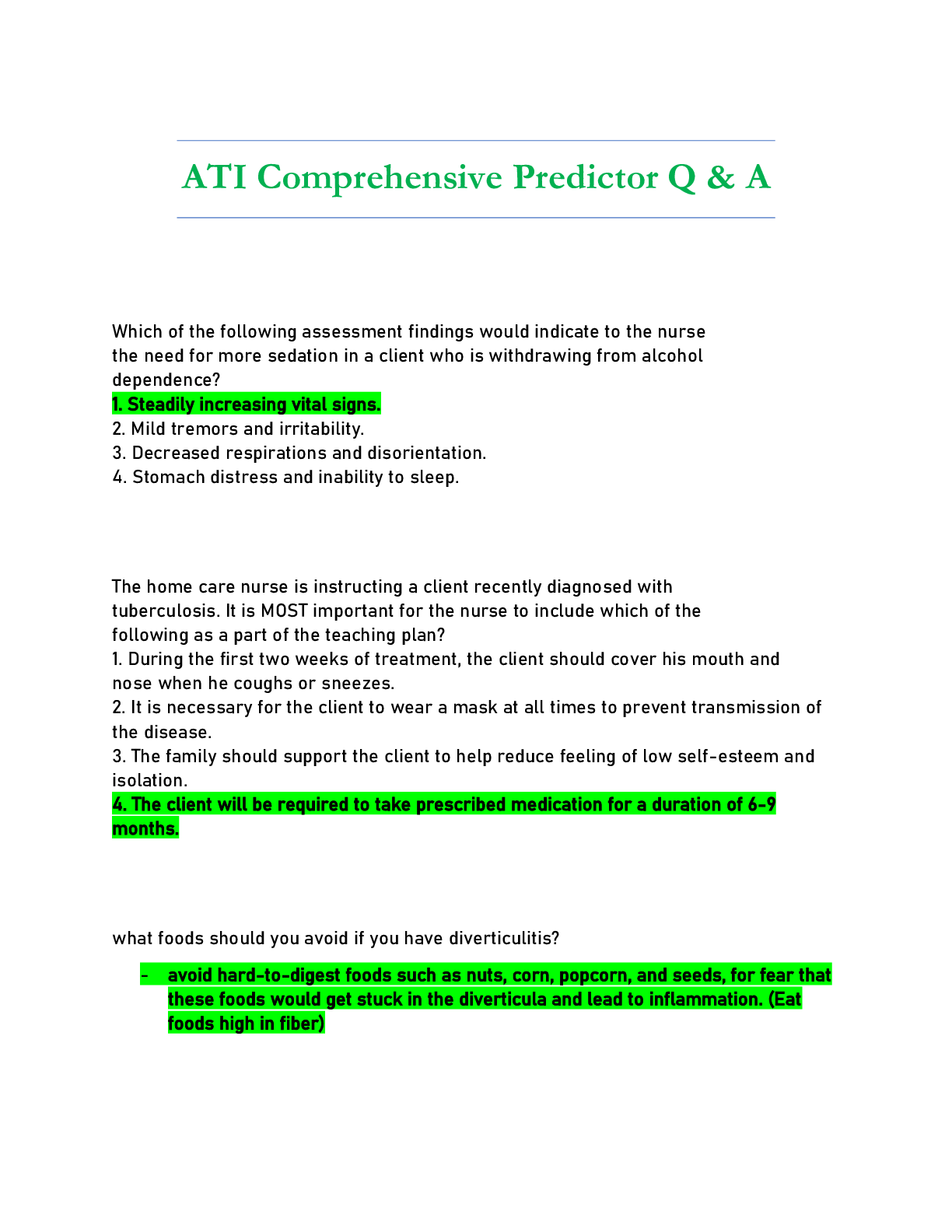
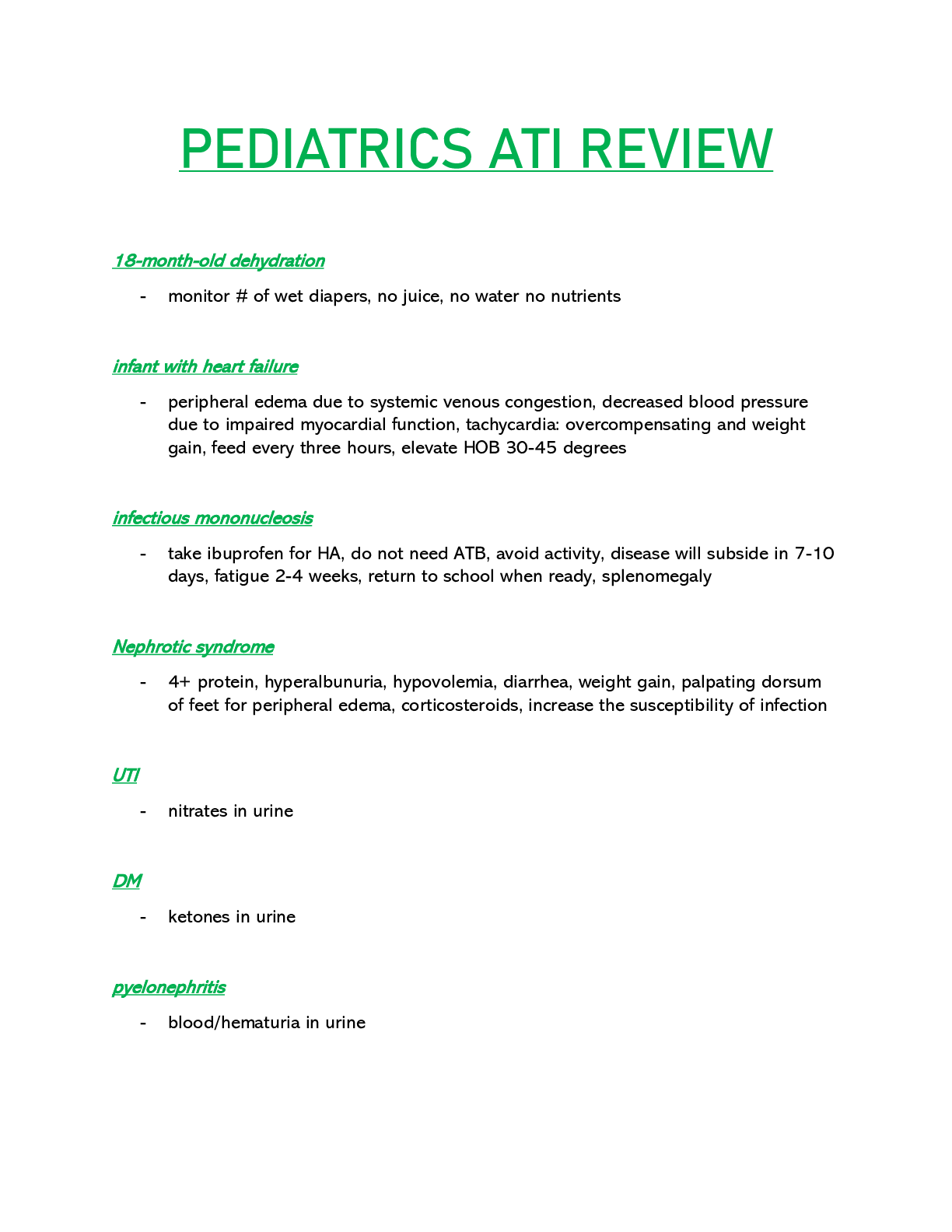
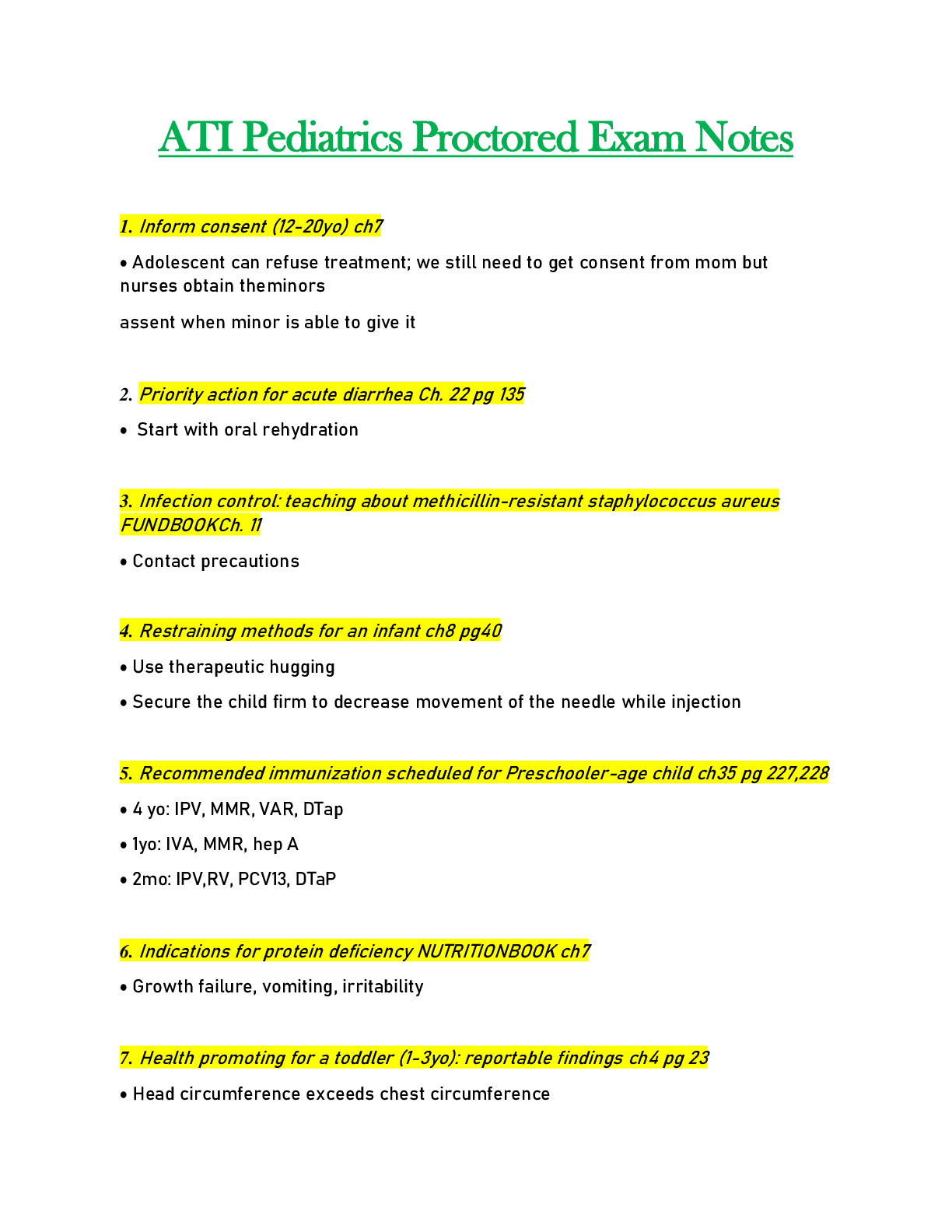
 MY21.png)
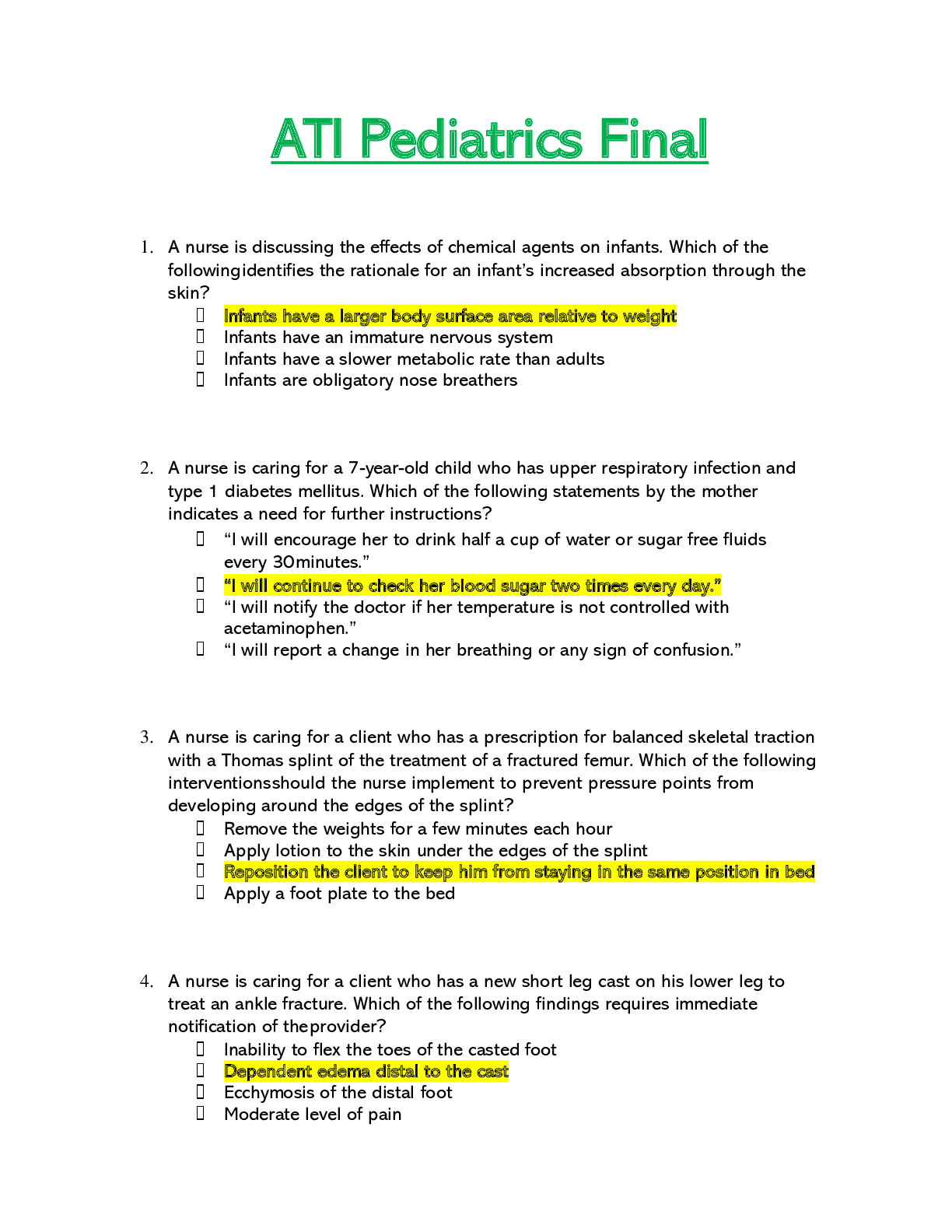
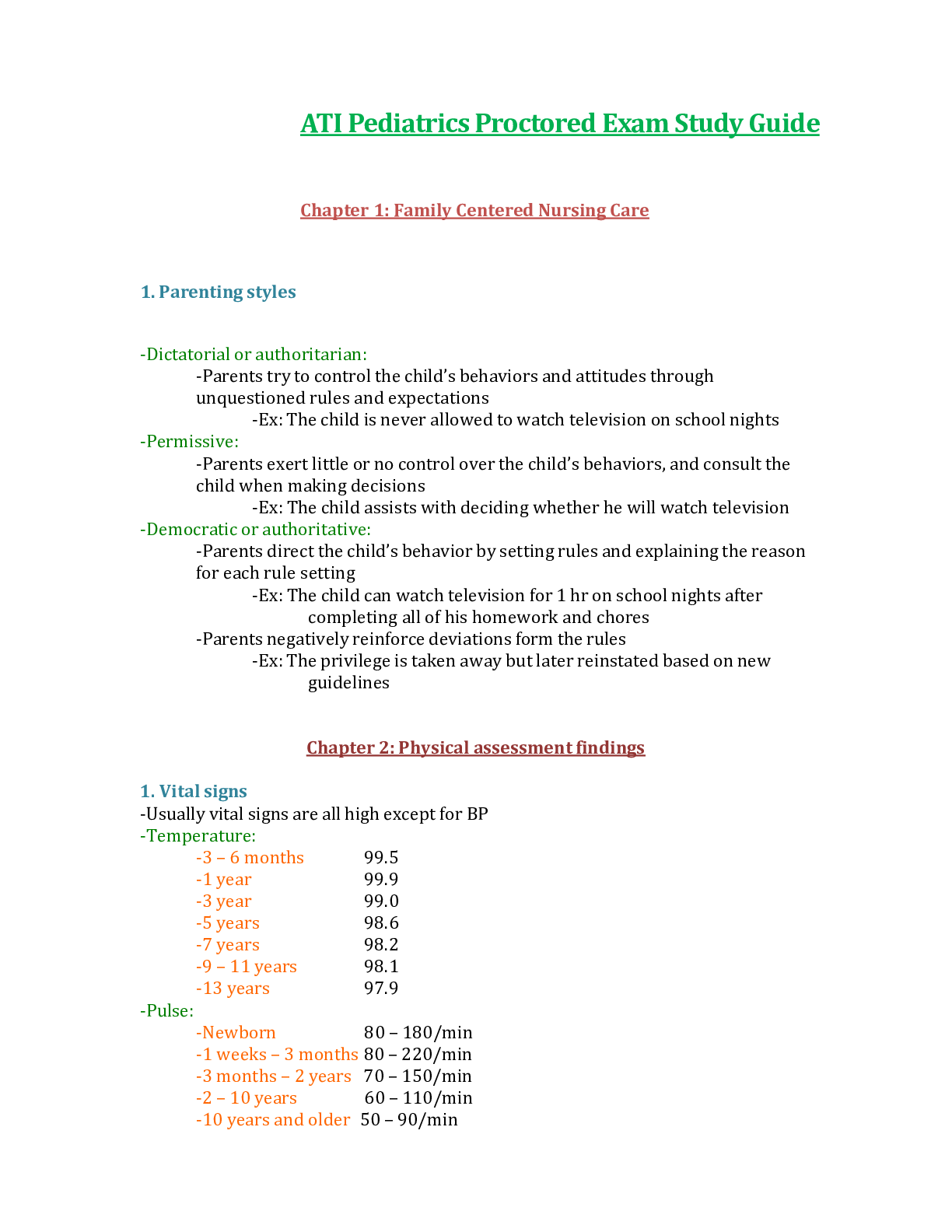
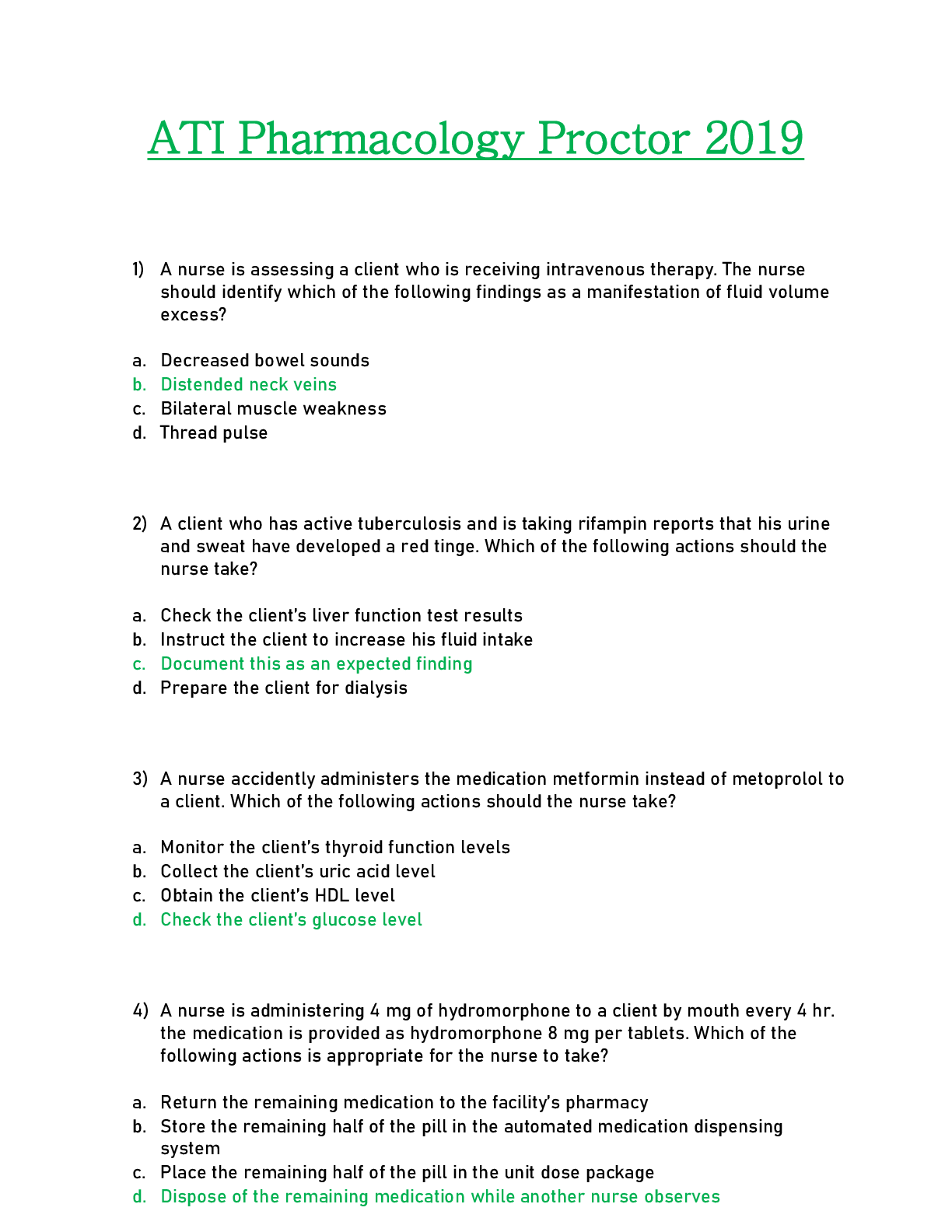
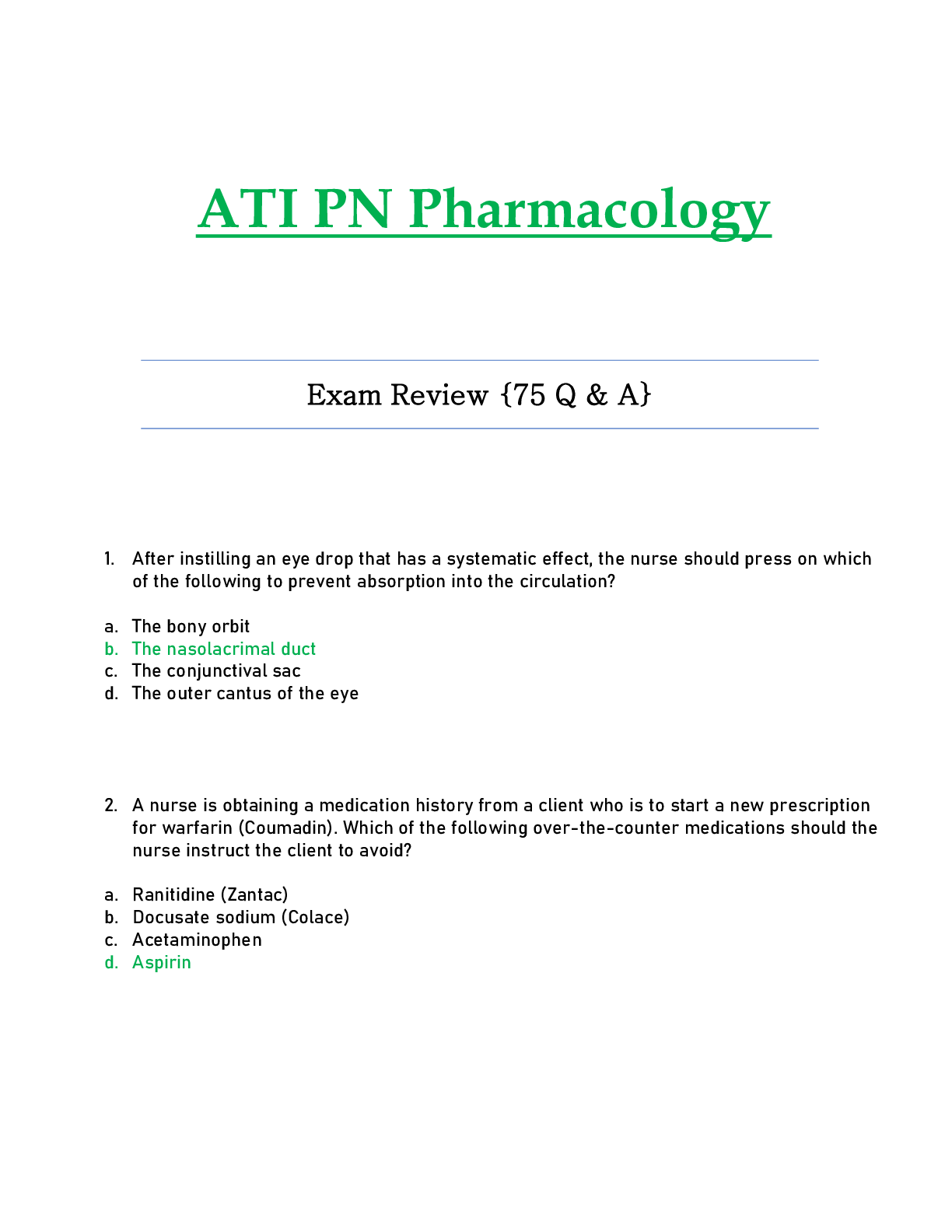
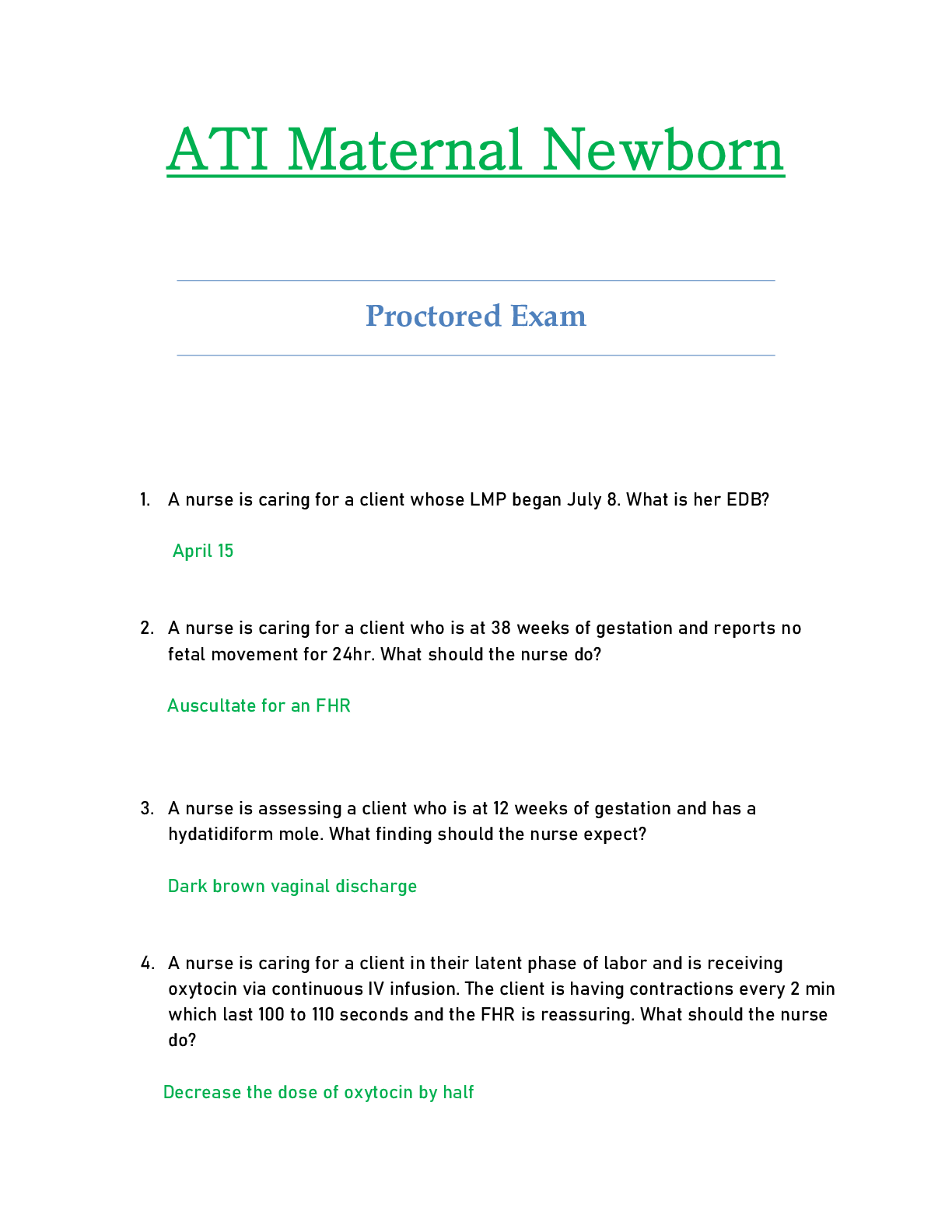
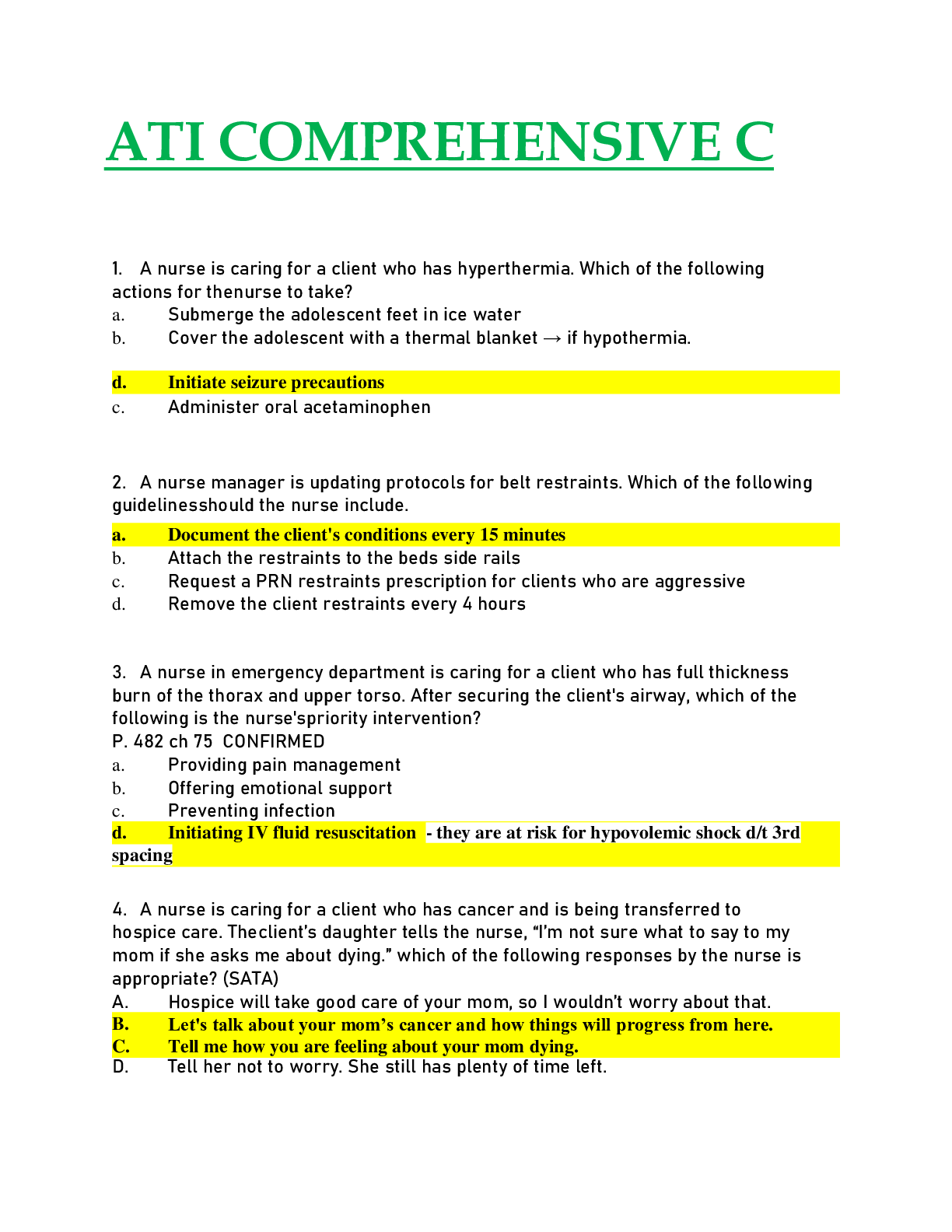
.png)
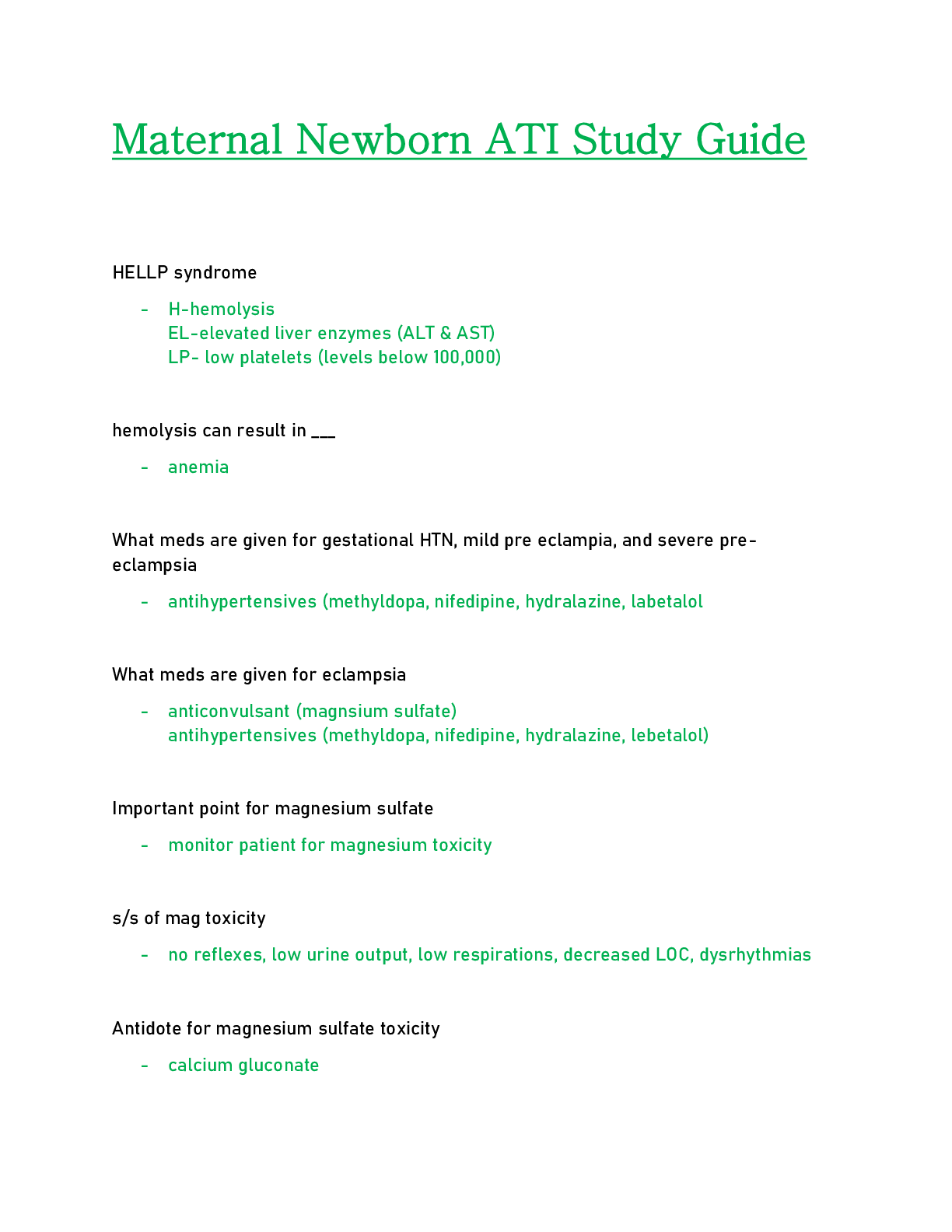
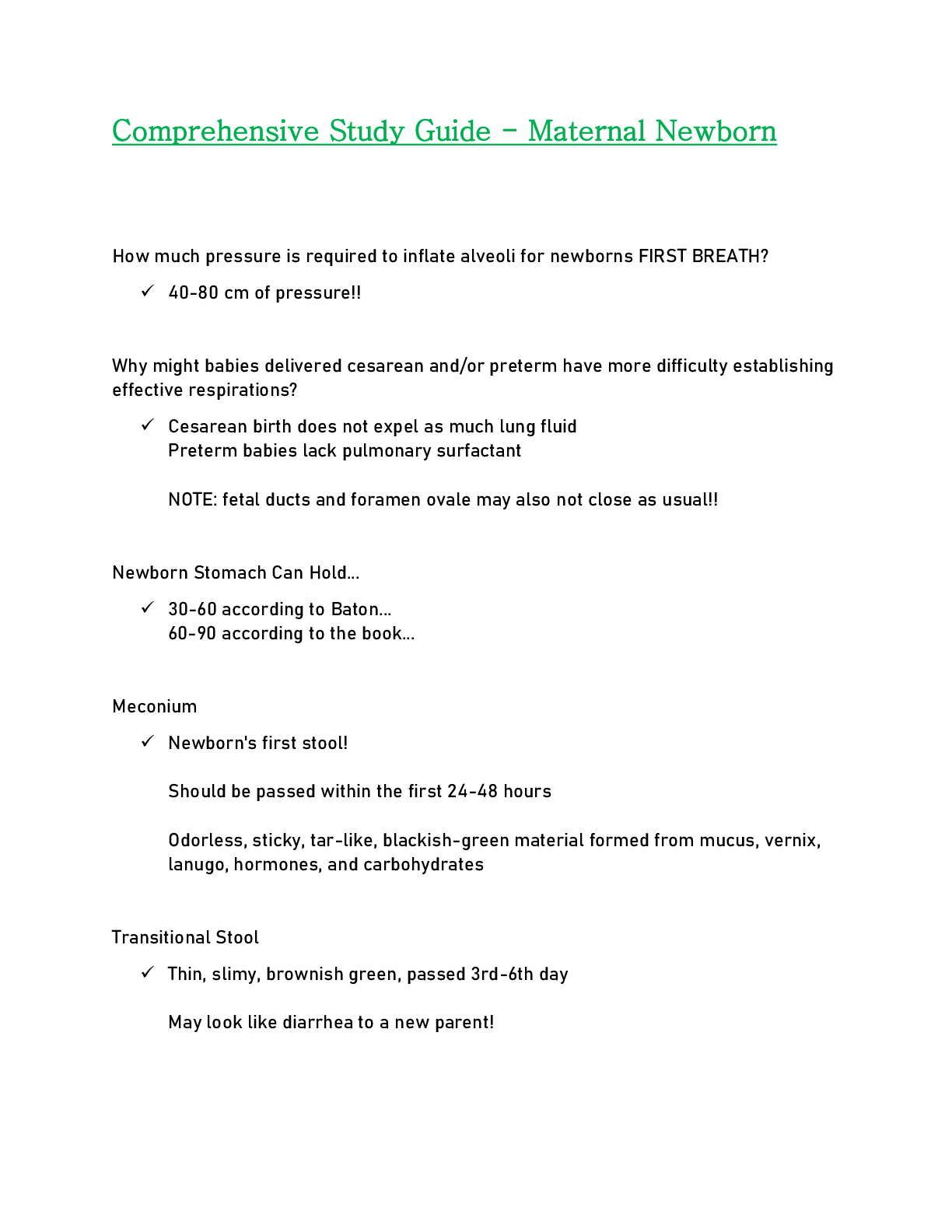
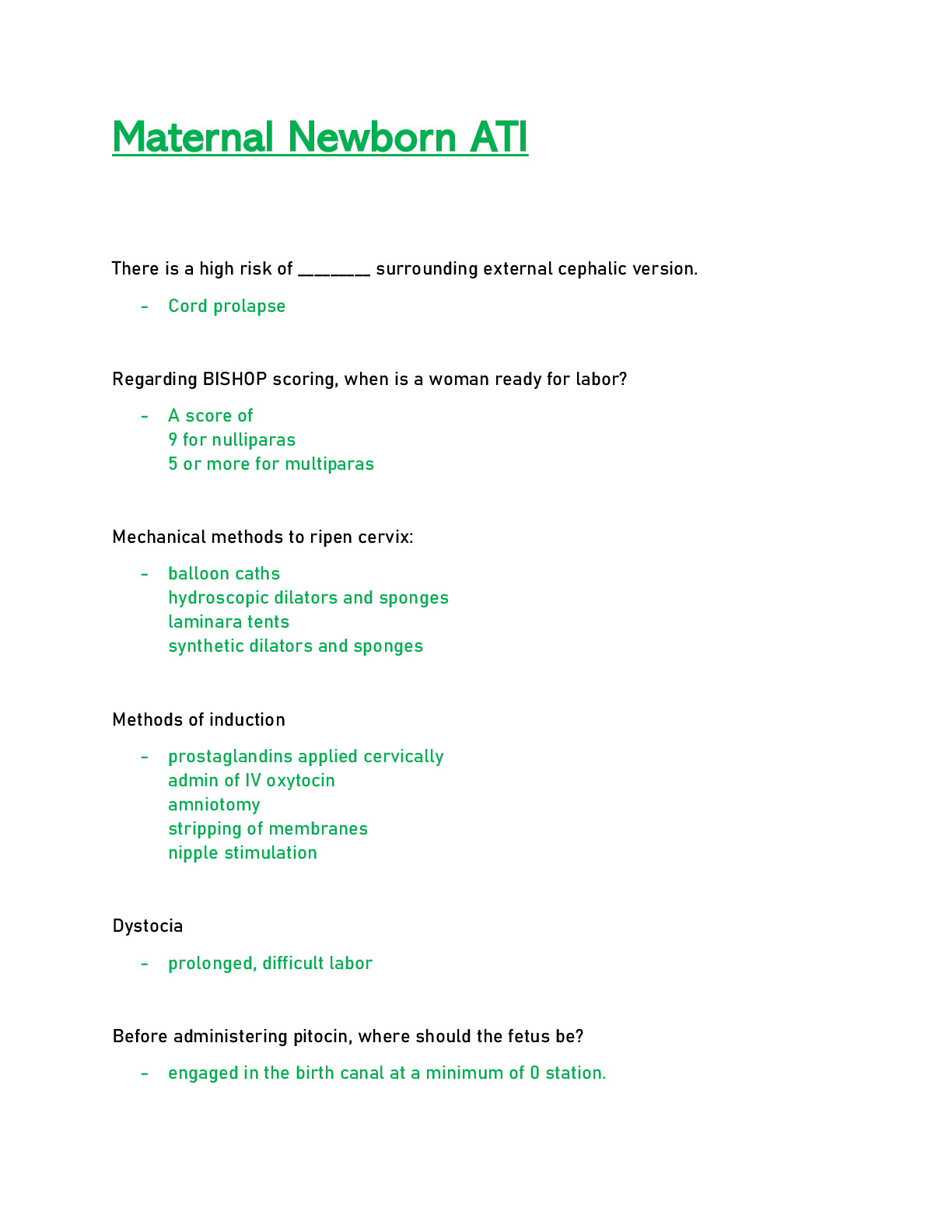
.png)
 A21.png)




